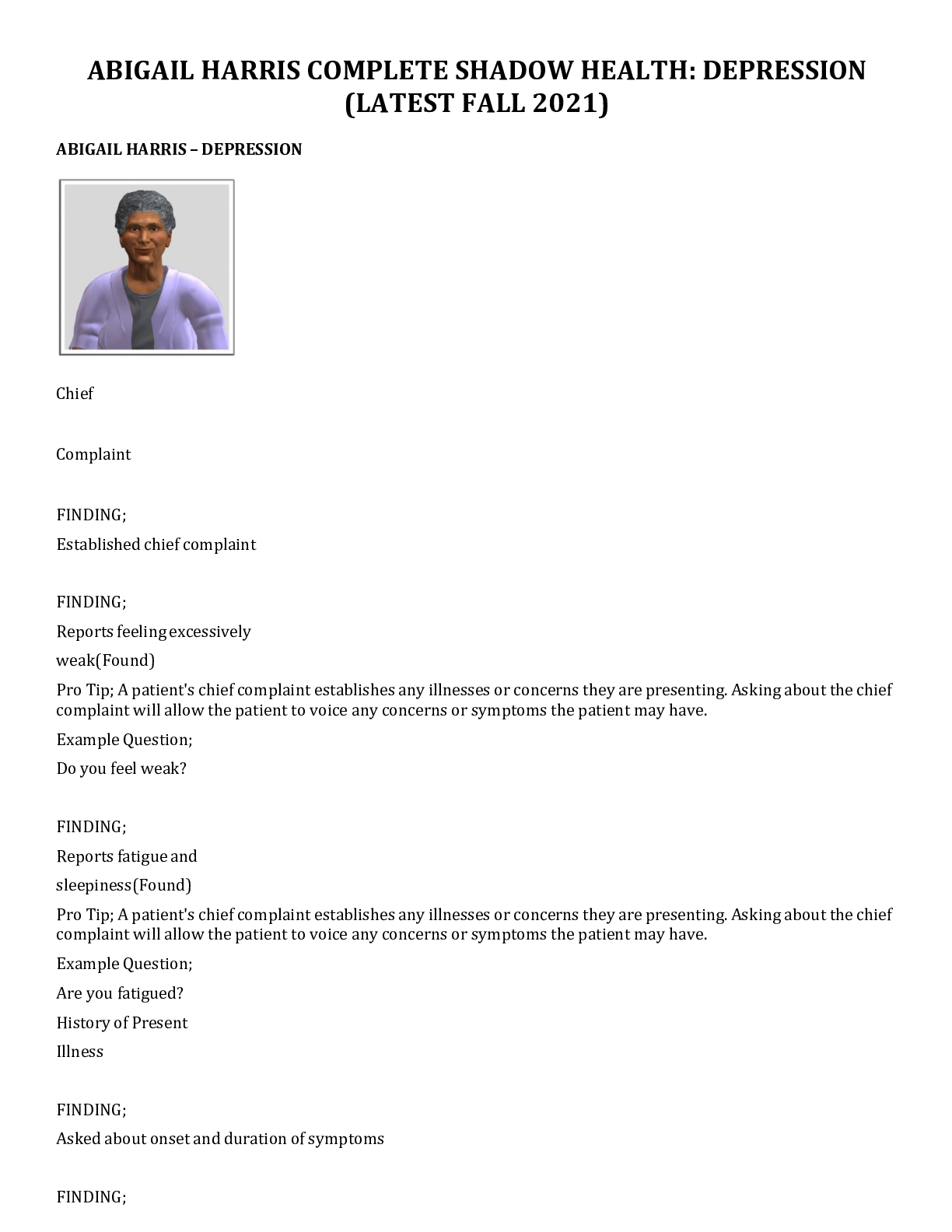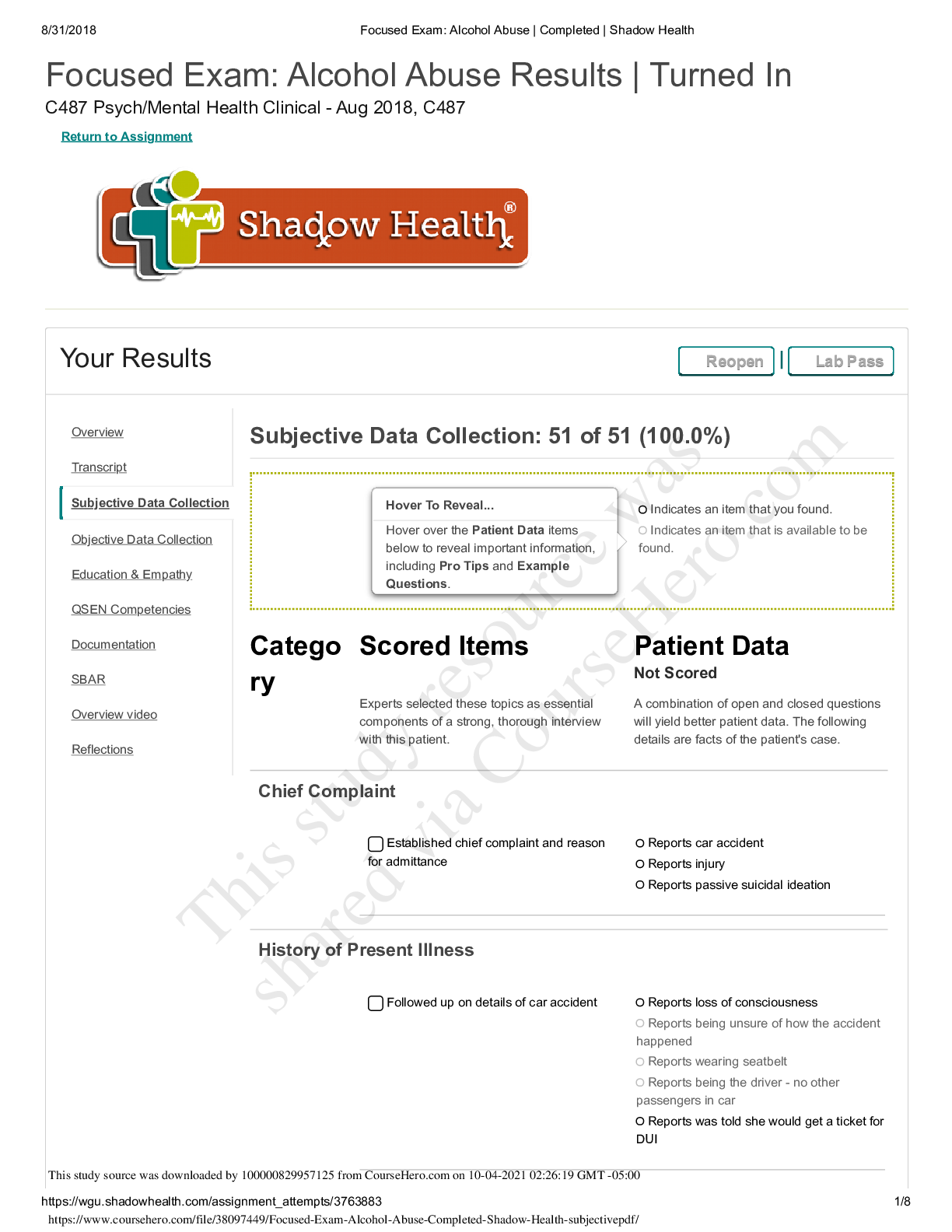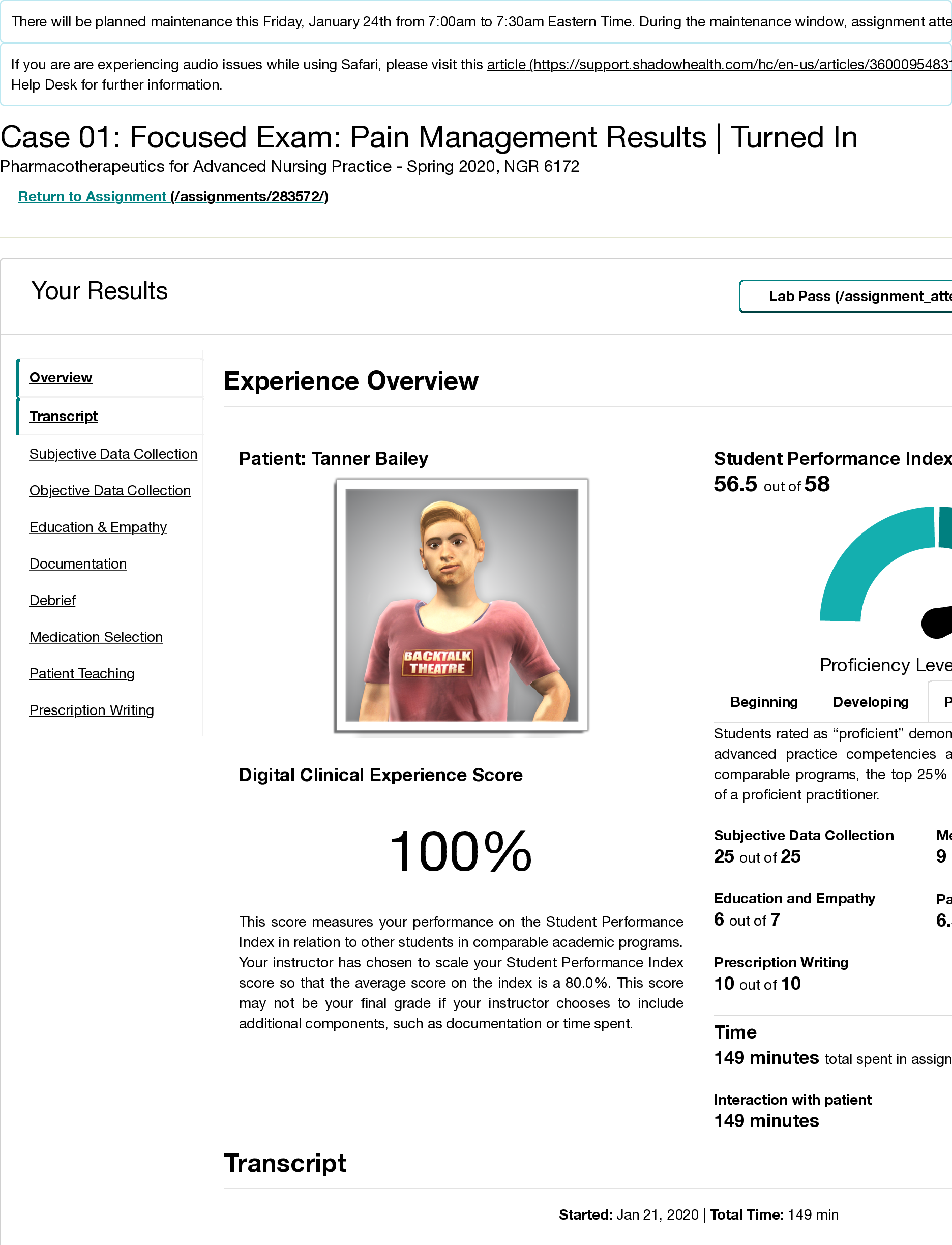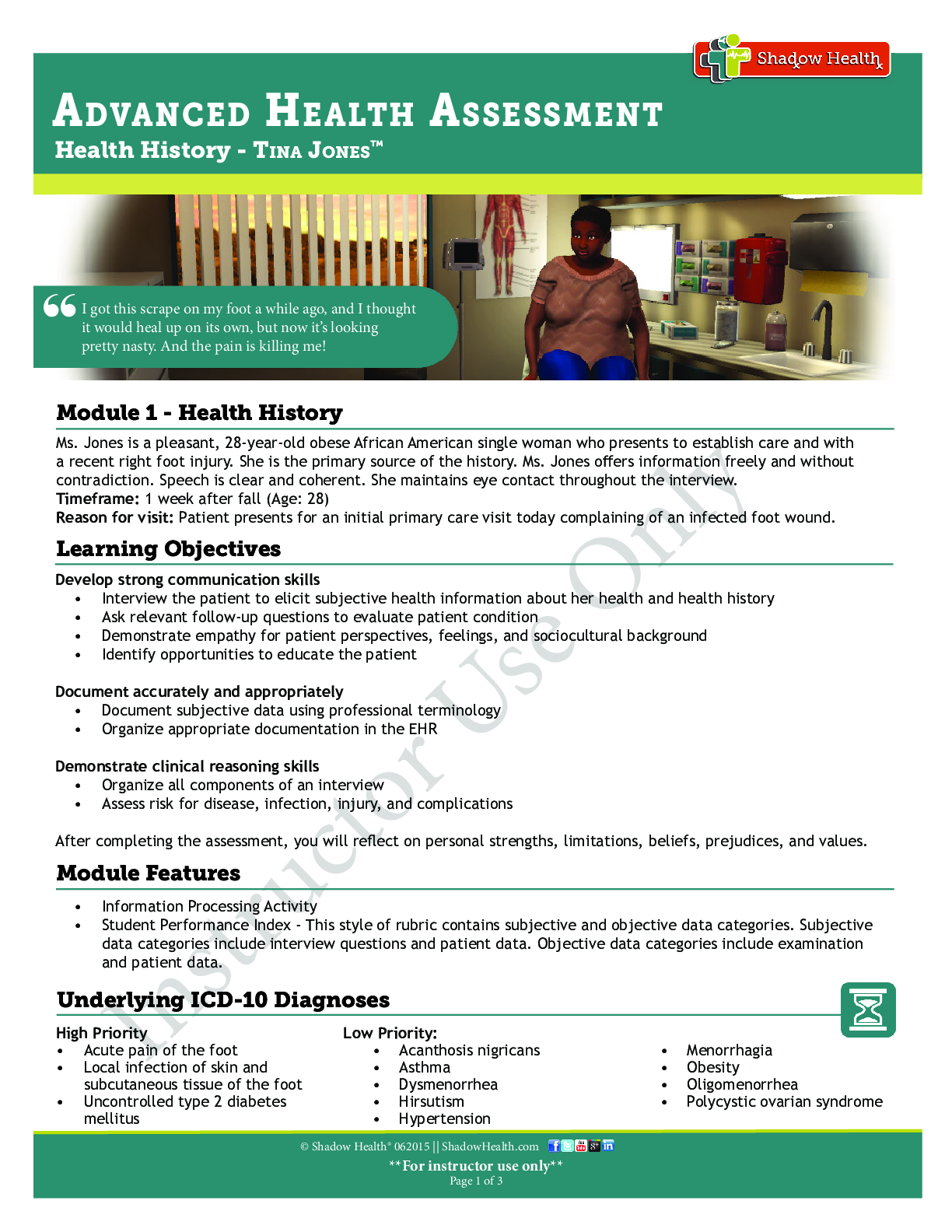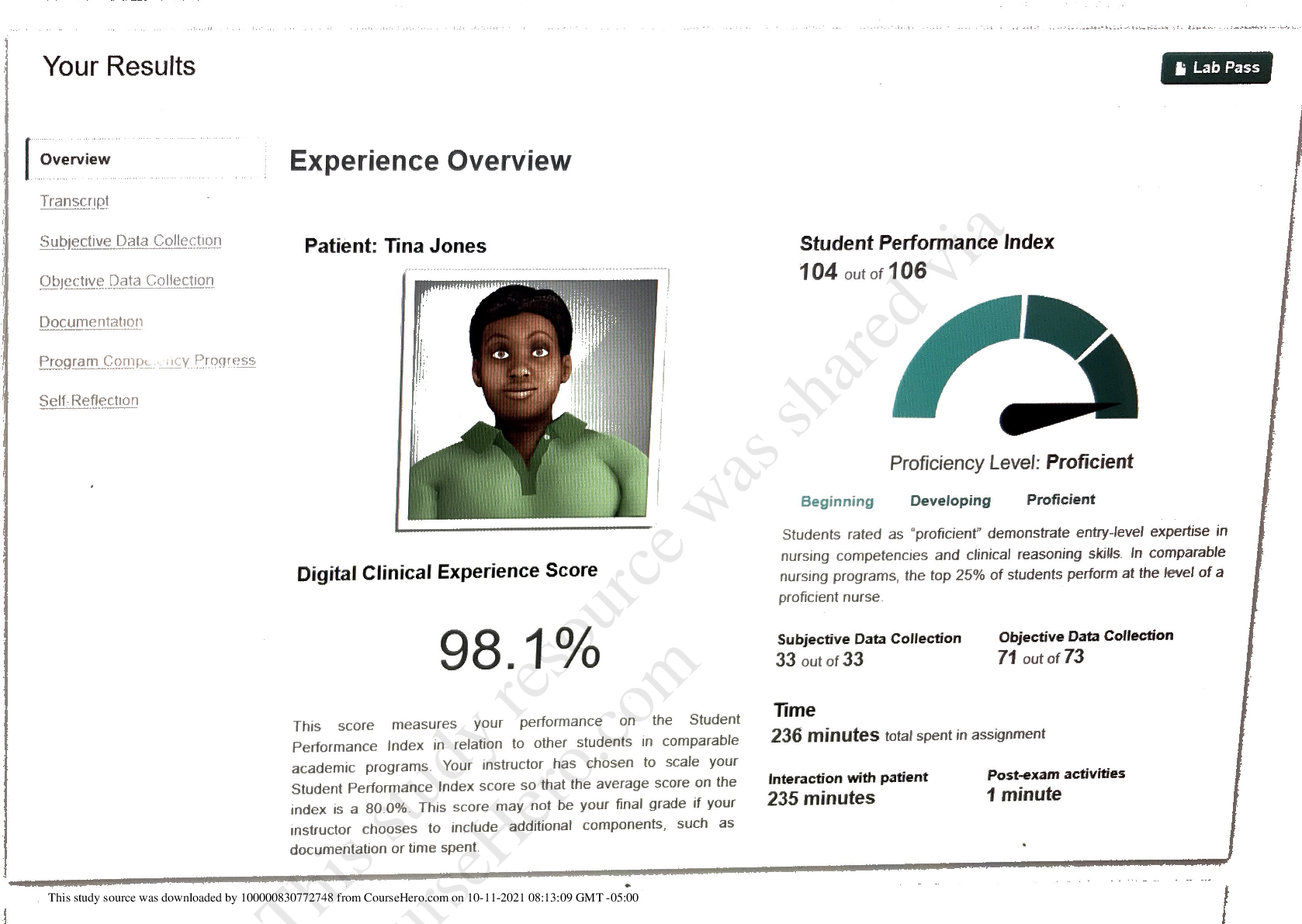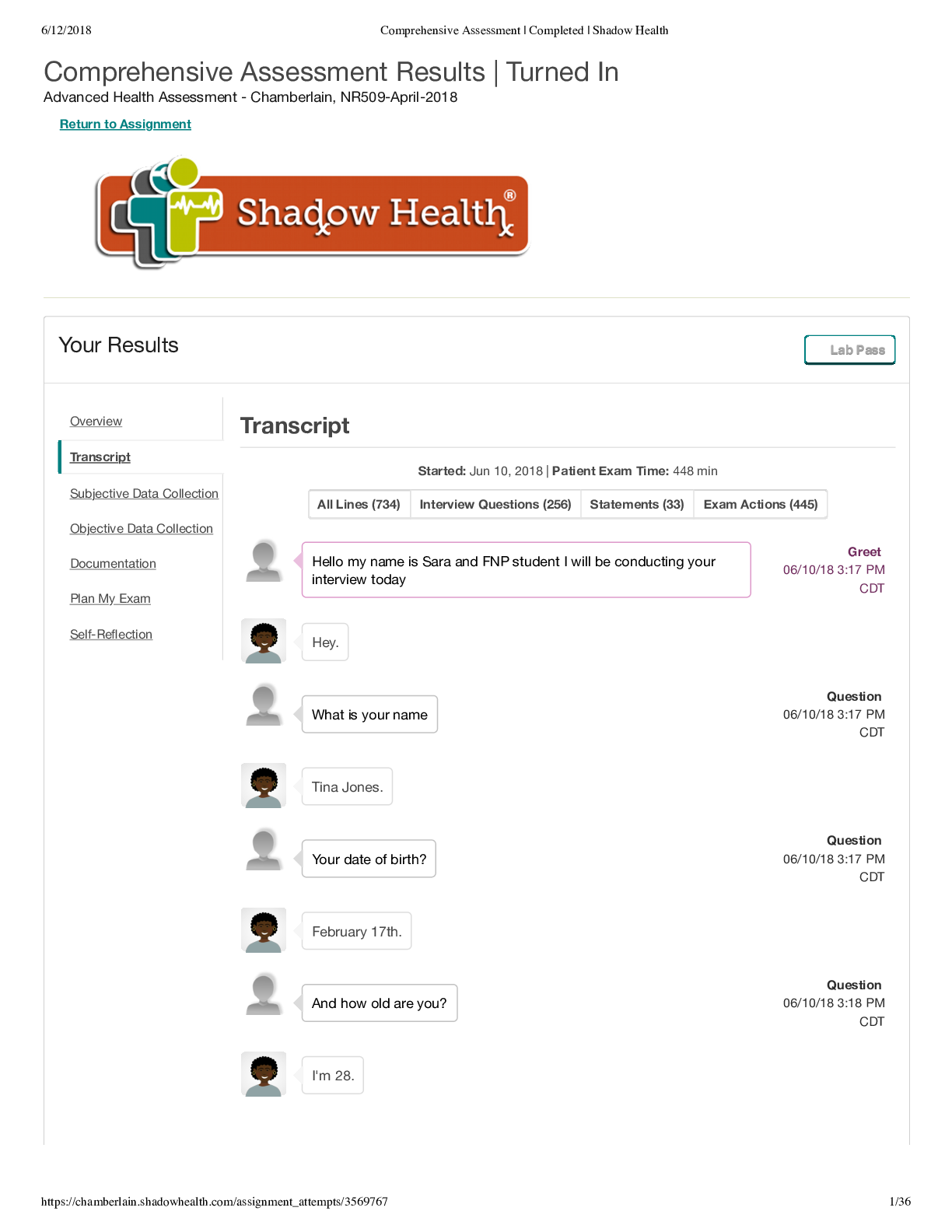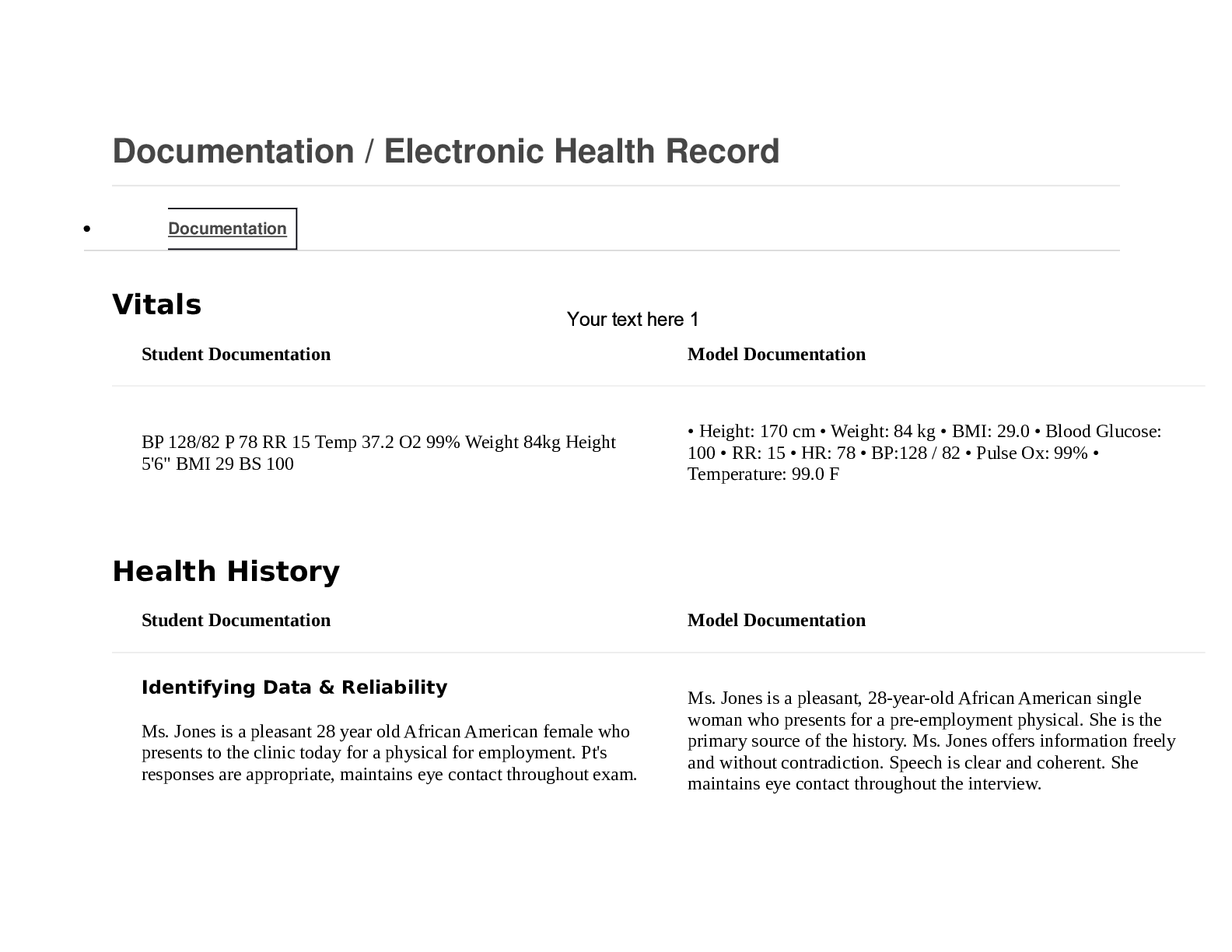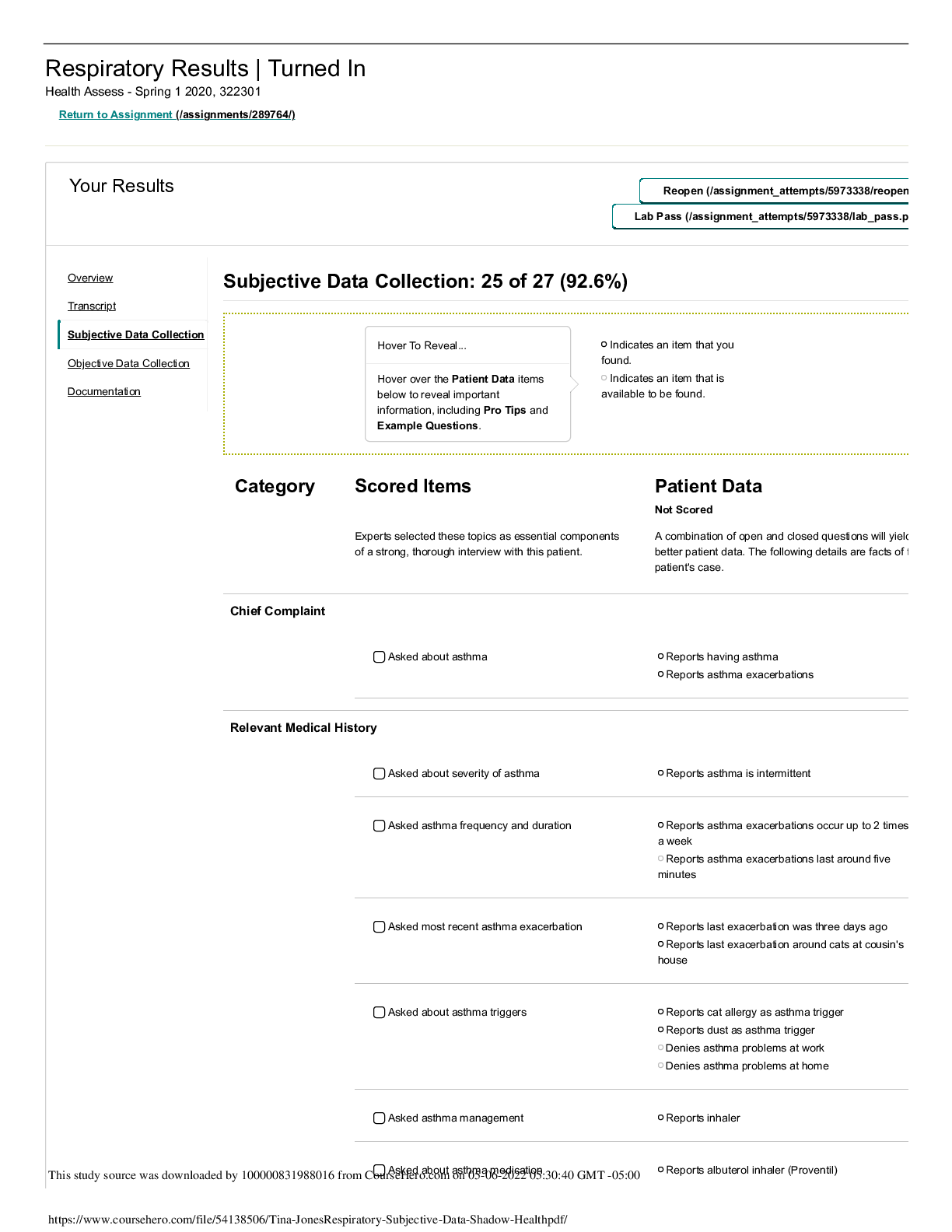*NURSING > SHADOW HEALTH > Normal Newborn UNFOLDING Reasoning Baby Boy Jones, 1 hour old (All)
Normal Newborn UNFOLDING Reasoning Baby Boy Jones, 1 hour old
Document Content and Description Below
Normal Newborn UNFOLDING Reasoning Baby Boy Jones, 1 hour old Normal Newborn Primary Concept Reproduction Interrelated Concepts (In order of emphasis) • Thermoregulation • Nutrition • P... erfusion • Pain • Clinical Judgment • Patient Education • Communication • Collaboration NCLEX Client Need Categories Percentage of Items from Each Category/Subcategory Covered in Case Study Safe and Effective Care Environment • Management of Care 17-23% ✓ • Safety and Infection Control 9-15% Health Promotion and Maintenance 6-12% ✓ Psychosocial Integrity 6-12% ✓ Physiological Integrity • Basic Care and Comfort 6-12% ✓ • Pharmacological and Parenteral Therapies 12-18% ✓ • Reduction of Risk Potential 9-15% ✓ • Physiological Adaptation 11-17% ✓ UNFOLDING Reasoning Baby Boy Jones, 1 hour old This study source was downloaded by 100000826504961 from CourseHero.com on 06-20-2022 06:39:00 GMT -05:00 https://www.coursehero.com/file/59116290/Normal-Newborn-Case-Study-Saturdaydocx/History of Present Problem One hour after Delivery: Anne is a 17-year-old, gravida 1 para 1 who is 39 weeks gestation. She recently experienced a normal spontaneous vaginal delivery without the use of pain medications or an epidural. She delivered a baby boy who was placed skin to skin following delivery. You assign Apgars of 8 and 9. Baby voided right after delivery. Weight: 7 lbs. 0 oz. (3.2 kg), 20 inches (50.8 cm) long. After he had his first feeding, erythromycin ointment was applied to his eyes. Vitamin K and hepatitis B vaccine (after consent given) were administered in right and left thigh in the outer aspect of the left thigh. Ann is Group Beta Strep (GBS) positive and received antibiotics at 36 weeks and 3 doses before delivery, blood type is B-, and rubella positive. Cord blood was sent. Personal/Social History: Anne has her mother with her for support. She seems to be tired but is holding and interacting with the baby appropriately. The father of the baby is not involved. Anne plans on breastfeeding for “awhile.” Anne still lives at home, and her mother plans to help with the new baby and appears supportive. What data from the histories are RELEVANT and must be interpreted as clinically significant by the nurse? (Reduction of Risk Potential) RELEVANT Data from Report: Clinical Significance: -Normal spontaneous delivery reported -No pain medications used -Apgar’s of 8 & 9 -Baby voided -All vaccines given to baby -There really isn’t anything of clinical significance here, perhaps because everything appears as either an expected finding and/or appropriate intervention and procedure. RELEVANT Data from Social History: Clinical Significance: -Patient’s mother is present as a support system— patient still lives at home with her -Baby’s father will not be involved -Patient plans on breastfeeding (for undetermined amount of time) -She is holding and interacting with baby -It appears that the patient is doing well at this point in time. She is interacting with her baby and wants to breast feed. She has a solid support system, which is important due to her young age. Patient Care Begins: You complete your assessment: Current VS: P-Q-R-S-T Pain Assessment: T: 97.0 F/36.1 C (axillary) Provoking/Palliative: P: 130 (regular) Quality: R: 50 (irregular) Region/Radiation: BP: none taken Severity: NIPS score 0 O2 sat: pink in color/no central cyanosis noted Timing: What VS data are RELEVANT and must be interpreted as clinically significant by the nurse? (Reduction of Risk Potential/Health Promotion and Maintenance) RELEVANT VS Data: Clinical Significance: -Temperature of 97.0 -Baby’s temp is lower than we’d like to see and he his respiratory rate is on the high end of acceptable range so it’s something I’m going to want to keep an eye on. But all other This study source was downloaded by 100000826504961 from CourseHero.com on 06-20-2022 06:39:00 GMT -05:00 https://www.coursehero.com/file/59116290/Normal-Newborn-Case-Study-Saturdaydocx/-RR of 50/irregular clinical findings are as expected, and he’s only been in this world for 1 hour. Current Assessment: GENERAL APPEARANCE: Calm, quiet, and in a crib next to the bed. RESP: Lusty cry, breath sounds clear, irregular, non-labored respiratory effort, no nasal flaring, no grunting noted. CARDIAC: Pink, warm & dry, heart sounds regular with no abnormal beats, pulses strong, acrocyanosis present in hands and feet, no central cyanosis noted. NEURO: Fontanelles flat and soft, good tone, slight flexion of arms and legs What assessment data are RELEVANT and must be interpreted as clinically significant by the nurse? (Reduction of Risk Potential/Health Promotion and Maintenance) RELEVANT Assessment Data: Clinical Significance: -Irregular respiratory rate is noted -Clear breath sounds, non-labored effort with no signs of distress -Heart sounds auscultated, neg for cyanosis -Fontanelles are within range and flexion is present -Flexion of arms and legs -Everything thing in this assessment appears with appropriate ranges and findings -The only abnormality is the irregular respiratory rate, however everything else indicates that baby is doing well and still in the adjustment phase -“Slight” flexion is reported Clinical Reasoning Begins… 1. Interpreting relevant clinical data, what is the primary concern? What primary health-related concepts does this primary problem represent? (Management of Care/Physiologic Adaptation) Problem: Pathophysiology of Problem in OWN Words: Primary Concept: -Our largest concern at this point is cold stress on the newborn -As the newborn was delivered at 39 weeks and has only been on the outside for about an hour, this is the time he is most susceptible to cold stress. Failure to prevent this causes an increase in metabolic activity which will have a negative impact on some of the other operating systems in the body. Full term babies remain in a flexed position to help maintain warmth, and this is also a time when skin to skin is important as well as frequent feeding. -This comes down to thermoregulation of the newborn This study source was downloaded by 100000826504961 from CourseHero.com on 06-20-2022 06:39:00 GMT -05:00 https://www.coursehero.com/file/59116290/Normal-Newborn-Case-Study-Saturdaydocx/Collaborative Care (Newborn Orders): Medical Management (Pharmacologic and Parenteral Therapies) Care Provider Orders: Rationale: Expected Outcome: -Vital signs q 30 mins until stable for 2 hrs—then every 4-6 hrs -May place skin to skin if vital signs stable -May bathe after 6-8 hours, then bathe prn -Recommend and encourage exclusive breastfeeding. Breastfeed PRN, minimum of 8-10 times in 24 hours. No more than four-hour gap in feedings. Feed infant based on feeding cues. Similac/Enfamil 6-10 mL every 3- 4 hours based on infant’s feeding cues -Weight at birth and then every evening -Input and Output every shift -Newborn work up (blood type, Coombs) if the mother is Rh negative -The newborn screen at greater than 24 hours -Transcutaneous bilirubin level prior to discharge -Newborn hearing screen before discharge -Congenital heart screening -It’s important to be frequently assessing the baby’s vitals in order to quickly determine if there is any type of change or decline -Skin to skin is essential in helping to thermoregulate the baby -Breastfeeding is the gold standard whenever possible, but if formula is being used, education needs to be provided so that it is being done appropriately -Weights should be performed at the same time of day and using the same scale. However, baby was weighed the first time should continue -I&Os help demonstrate if baby is eating enough since they are not able to speak and wear diapers -Bilirubin should be checked to confirm liver function -Hearing and CHD screenings should be tested prior to discharge to allow time for baby to acclimate and for fluid to exit places it should not be in -It’s expected that baby’s vitals signs are all within acceptable ranges during all checks. -The baby should be skin skin if stable with frequent breastfeeding performed. -They should be getting weight twice a day every day, and I&Os should be consistently monitored until discharge -Bilirubin levels will be within normal ranges prior to discharge to ensure no occurrence of jaundice -All screenings, including hearing and CHD will be completed prior to discharge but after 24hrs after birth Collaborative Care: Nursing 2. What body system(s) will you assess most thoroughly based on the primary/priority concern? (Reduction of Risk Potential/Physiologic Adaptation) PRIORITY Body System: PRIORITY Nursing Assessments: The two systems we’re going to assess the most are the respiratory and cardiovascular, as these two systems will show reveal manifestations the earliest. -Assessment of vital signs for the first three hours is essential. Temperature and all other VS should be getting assessed every 30min for the first couple of hours after birth until the newborn has demonstrated stability in all areas This study source was downloaded by 100000826504961 from CourseHero.com on 06-20-2022 06:39:00 GMT -05:00 https://www.coursehero.com/file/59116290/Normal-Newborn-Case-Study-Saturdaydocx/3. What nursing priority (ies) will guide your plan of care? (Management of Care) Nursing PRIORITY: Maintain a neutral thermal environment PRIORITY Nursing Interventions: Rationale: Expected Outcome: -Frequently assess the newborn’s vital signs to monitor for signs of cold stress -Maintain the baby in a warm environment until stable by preventing a bath until stable, assisting with skin to skin, and ensuring there are frequent feeds for the baby. Keeping tabs on the newborn’s vitals on a more frequent basis can alert us to any variations in a timelier manner. We then have the opportunity for early intervention and stand a greater chance of a better outcome. Vitals signs will be performed frequently to assess the newborn for signs of cold stress and take necessary steps to maintain a neutral thermal environment. 4. What psychosocial/holistic care PRIORITIES need to be addressed for this patient? (Psychosocial Integrity/Basic Care and Comfort) Psychosocial PRIORITIES: This really cannot be geared as much to the infant as much as to his mother. PRIORITY Nursing Interventions: Rationale: Expected Outcome: CARE/COMFORT: Assess the mother for any signs of discomfort and take any necessary steps to increase comfort level If mom isn’t comfortable and reports an increased pain scale, it will be more difficult for her to take care of her infant. A mom that is comfortable and has successfully managed her pain has the energies to focus on taking care of her baby (i.e. breastfeeding/skin to skin). Mom will be able to more frequently breastfeed and maintain skin to skin contact with her infant since she is resting comfortably and has minimal pain to report. EMOTIONAL (How to develop a therapeutic relationship): Discuss the following principles needed as conditions essential for a therapeutic relationship: • Rapport • Trust • Respect • Genuineness • Empathy Adaption to the role of mother It’s important to develop a dialogue and a trust with the mother of the infant. She needs to be made aware that you are If a patient feels that there is a genuine trust and that you can empathize with her situation, it is easier for her to trust you. This is especially important if she is feeling overwhelmed or perhaps suffering from some type of post-partum episode or has feelings about hurting her child. Mom will actively communicate any questions or concerns she may have about the state of her health and the care of her newborn so that appropriate inventions can be taken to address any questions or concerns. This study source was downloaded by 100000826504961 from CourseHero.com on 06-20-2022 06:39:00 GMT -05:00 https://www.coursehero.com/file/59116290/Normal-Newborn-Case-Study-Saturdaydocx/there to take care of her equally as much as her baby. SPIRITUAL: • F-Faith or beliefs • I-Importance and influence • C-Community • A-Address Make sure all spiritual beliefs are acknowledged and addressed with the patient. Try to incorporate any customs associated with these beliefs in the plan of care if they do not pose any threat to the health of mom or baby. Again, this comes down to respect and communication. Demonstrating respect for your patient and actively trying to prioritize her spiritual beliefs or customs will make communicating easier. All steps to incorporate spiritual beliefs into the patient’s plan of care will be taken so that patient can freely communicate her feelings with fear of being judge and those feelings can then be addressed. History of Present Problem 7:00 am First Day Post-Delivery Night Shift Report: Baby has breastfed with a good latch six times in the last 12 hours. Anne is holding and talking to her baby, looking at him and calling him by name. She plans on having the baby circumcised. The baby had three wet and one meconium diaper since birth. Cord blood was sent to lab. Current VS: P-Q-R-S-T Pain Assessment: T: 97.7 F/36.5 C (axillary) Provoking/Palliative: P: 130 (regular) Quality: R: 50 (irregular) Region/Radiation: BP: none taken Severity: NIPS score 0 O2 sat: pink in color Timing: 1200 Assessment and Rounding Anne has just finished breastfeeding, but she expresses concern that she isn’t doing it correctly. She asks how to tell if baby is eating enough. She tells you she has decided to name the baby James. Her mom is at bedside and appears supportive. Current VS: P-Q-R-S-T Pain Assessment: T: 98.6 F/37 C (axillary) Provoking/Palliative: P: 130 (regular) Quality: R: 50 (irregular) Region/Radiation: BP: none taken Severity: NIPS score 0 O2 sat: pink in color Timing: This study source was downloaded by 100000826504961 from CourseHero.com on 06-20-2022 06:39:00 GMT -05:00 https://www.coursehero.com/file/59116290/Normal-Newborn-Case-Study-Saturdaydocx/Current Assessment: GENERAL APPEARANCE: Calm, quiet, and in a crib next to the bed. RESP: Lusty cry, breath sounds clear, irregular, non-labored respiratory effort, no nasal flaring, no grunting noted. CARDIAC: Pink, warm & dry, heart sounds regular with no abnormal beats, pulses strong, acrocyanosis present in hands and feet NEURO: Fontanelles flat and soft. Baby has good tone, slight flexion of arms and legs 1. What data is RELEVANT and must be interpreted as clinically significant by the nurse? (Reduction of Risk Potential/Health Promotion and Maintenance) RELEVANT VS Data: Clinical Significance: Temperature: 98.6 Almost everything has remained unchanged during the last couple of vitals assessments. The only thing of clinical significance is the fact that the baby’s body temperature and progressively trended upwards and is now within an acceptable range. RELEVANT Assessment Data: Clinical Significance: All assessment data remains unchanged from the previous assessment. This is a no news is good news type of situation. There isn’t anything new to report on assessment, but everything from previous assessments was with normal ranges, which is what we want to see. 2. Has the status improved or not as expected to this point? Does your nursing priority or plan of care need to be modified in any way after this evaluation assessment? (Management of Care, Physiological Adaptation) Evaluation of Current Status: Modifications to Current Plan of Care: The baby’s status has since improved since birth. No modifications are need to the current plan of care. 3. Based on your current evaluation, what are your CURRENT nursing priorities and plan of care? (Management of Care) CURRENT Nursing PRIORITY: Provide patient further education on the care of a newborn. PRIORITY Nursing Interventions: Rationale: Expected Outcome: -Connect patient with a support group of It’s quite possible the patient has no experience with a newborn, nor does The patient will interact and connect with other mothers of newborns of all different This study source was downloaded by 100000826504961 from CourseHero.com on 06-20-2022 06:39:00 GMT -05:00 https://www.coursehero.com/file/59116290/Normal-Newborn-Case-Study-Saturdaydocx/mothers’ and enroll her in some type of parenting class. she interact with someone who does on a daily basis. This is important for her to have during the transition to motherhood. ages and be able to establish relationships while gaining some knowledge via instruction and through the experience of those she is associating with in her group 1600 Assessment and Rounding… Anne is worried about how she will manage when she goes home with the new baby. “I never even babysat when I was younger or helped take care of younger siblings”. She also asks you about getting the baby circumcised, "Will it hurt the baby and how do I take care of it?" Anne also expresses concern about what will happen when she goes back to work in six weeks. She wants to know when "she'll be back to normal." You teach her infant care, signs and symptoms to report. You encourage her to attend a mother support group and provide her with local resources for ongoing mentoring and support. Education Priorities What educational priorities will be needed to develop a teaching plan for this patient and/or family? (Health Promotion and Maintenance) Education PRIORITY: This was already utilized upon the change to the nursing priority, but enrollment in some type of parenting education class will be monument for this patient. She has very little exposure of knowledge of the situation that she finds herself in and will need some type of intervention as soon as possible. PRIORITY Topics to Teach: Rationale: 1. Parenting 101 Overview of caring for a newborn on a daily basis (i.e. bathing, feeding, swaddling, etc.) 2. Breastfeeding 101 Overview on breastfeeding and proper techniques as well as navigating the problems along the way and who to contact and when. As this is her first child and she has no real experience with newborns, it’s vital that the patient be provided a comprehensive overview of caring for her newborn. This should include all the day to day activities involved in parenting as well as identifying problems and how to manage said issues. Forty-eight hours After Delivery… Anne is stable and at 48 hours, her doctor discharges her. RhoGAM was given as ordered. Discharge teaching has been completed. Baby has been cleared for discharge as well. James’ assessment is as follows: RELEVANT Data: Clinical Significance: Term infant being discharged after being cleared to be discharged home. Mom and baby are both doing well. Both patient’s vitals are stable. Mom and baby have demonstrated appropriate levels of health to be able to be discharged. This study source was downloaded by 100000826504961 from CourseHero.com on 06-20-2022 06:39:00 GMT -05:00 https://www.coursehero.com/file/59116290/Normal-Newborn-Case-Study-Saturdaydocx/Caring and the “Art” of Nursing What is the patient likely experiencing/feeling right now in this situation? What can you do to engage yourself with this patient’s experience, and show that he/she matters to you as a person? (Psychosocial Integrity) What Patient is Experiencing: How to Engage: The patient is probably feeling very nervous and scared. There’s no doubt some feeling of excitement, but fear of the unknown or fear of failure or injury to the baby is probably the strongest emotion at this point. [Show More]
Last updated: 1 year ago
Preview 1 out of 9 pages

Reviews( 0 )
Document information
Connected school, study & course
About the document
Uploaded On
Nov 08, 2022
Number of pages
9
Written in
Additional information
This document has been written for:
Uploaded
Nov 08, 2022
Downloads
0
Views
31

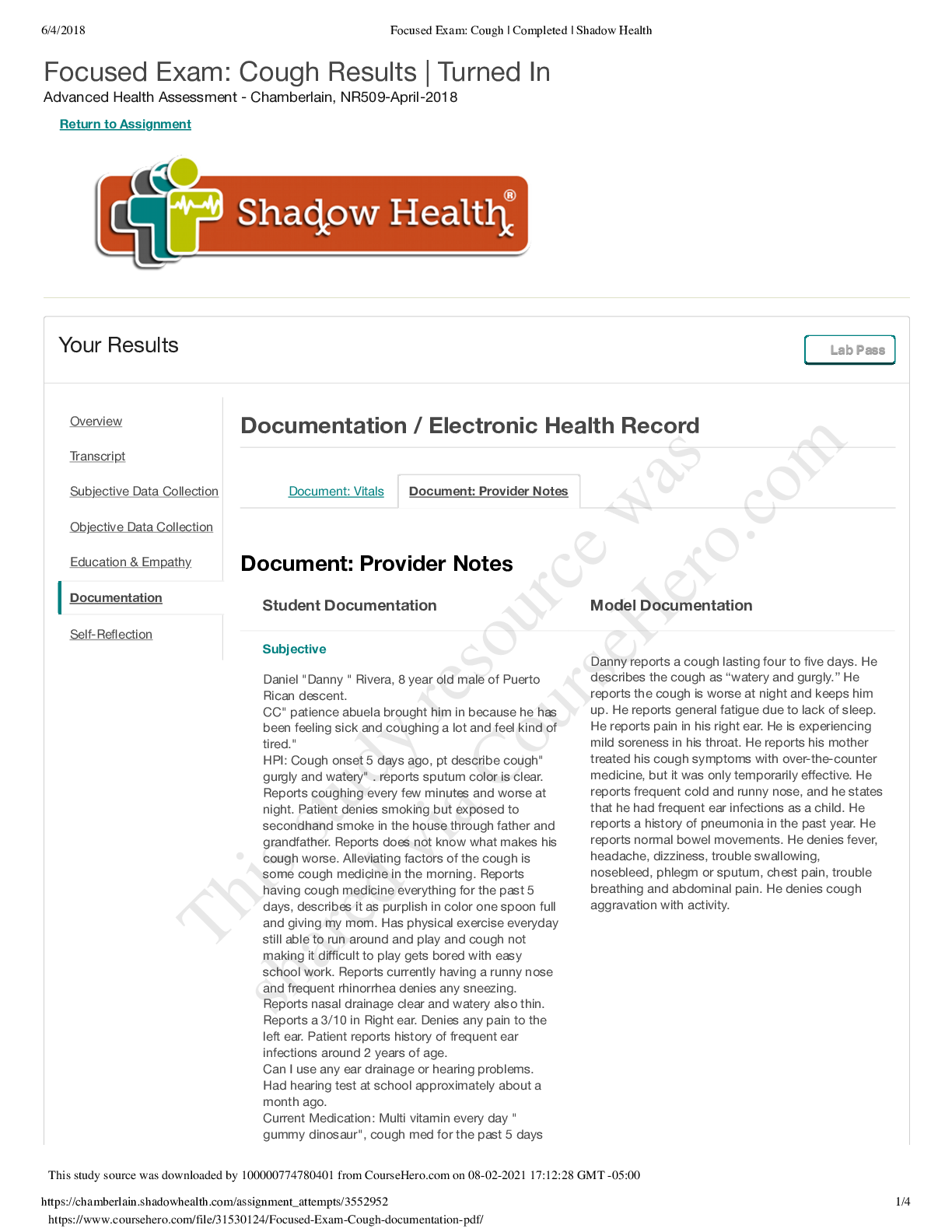



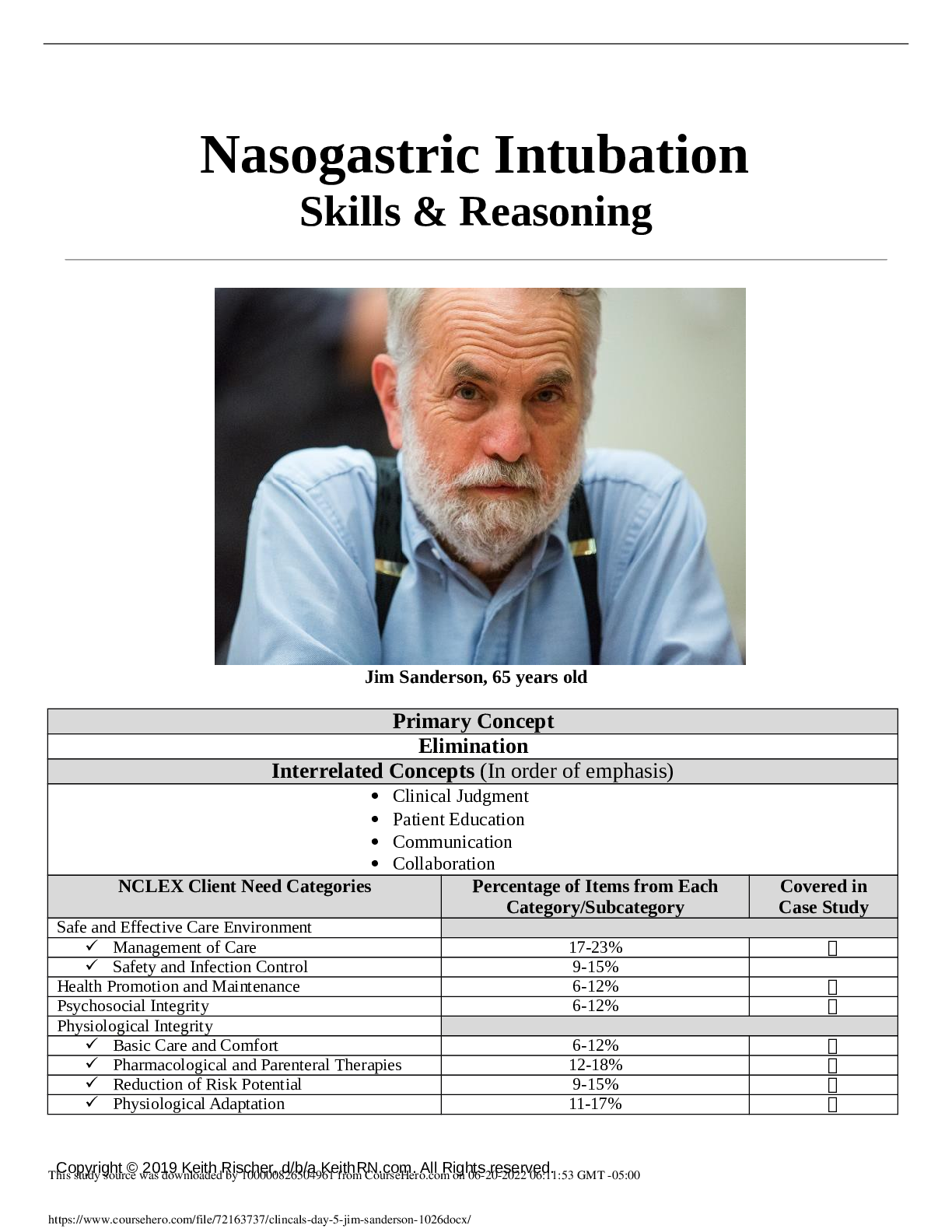

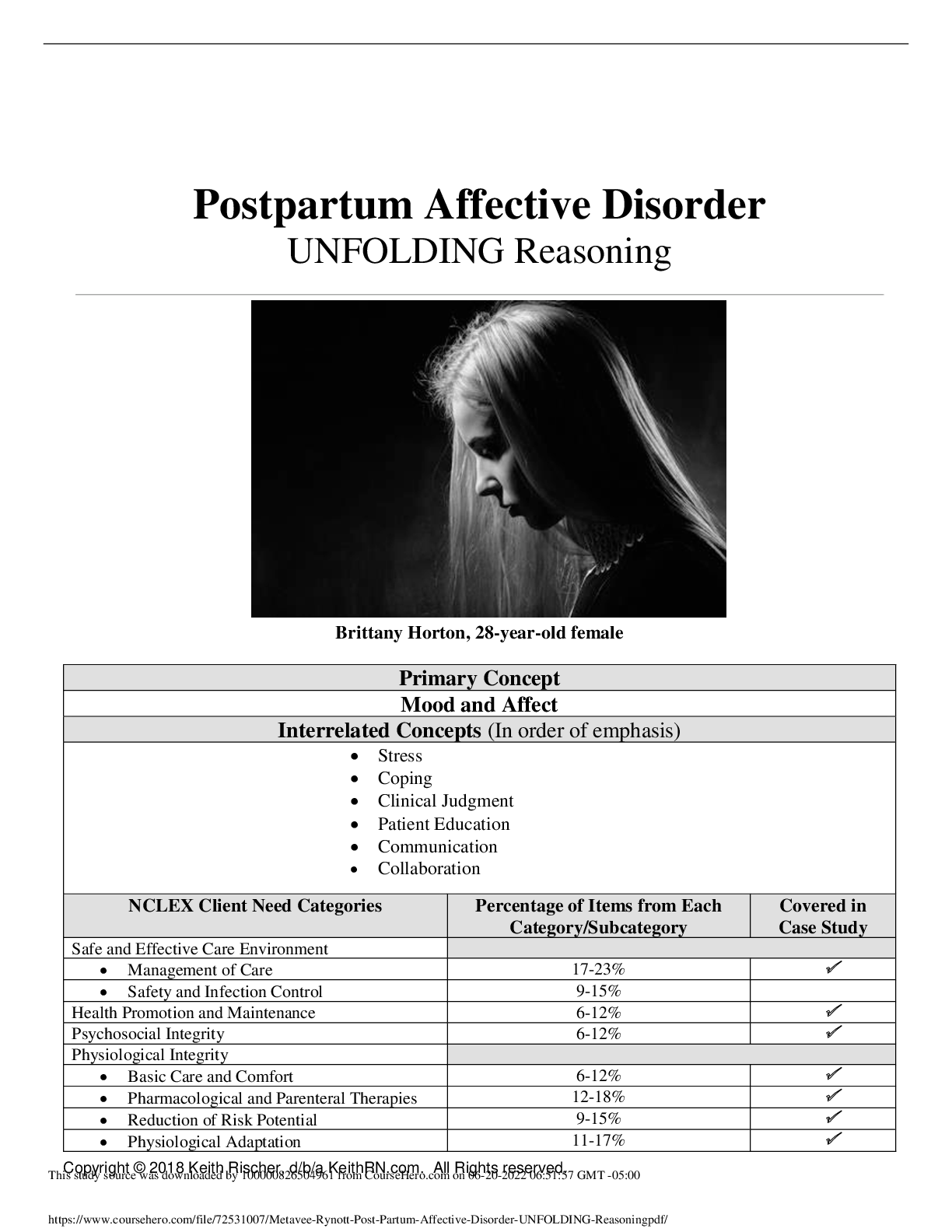

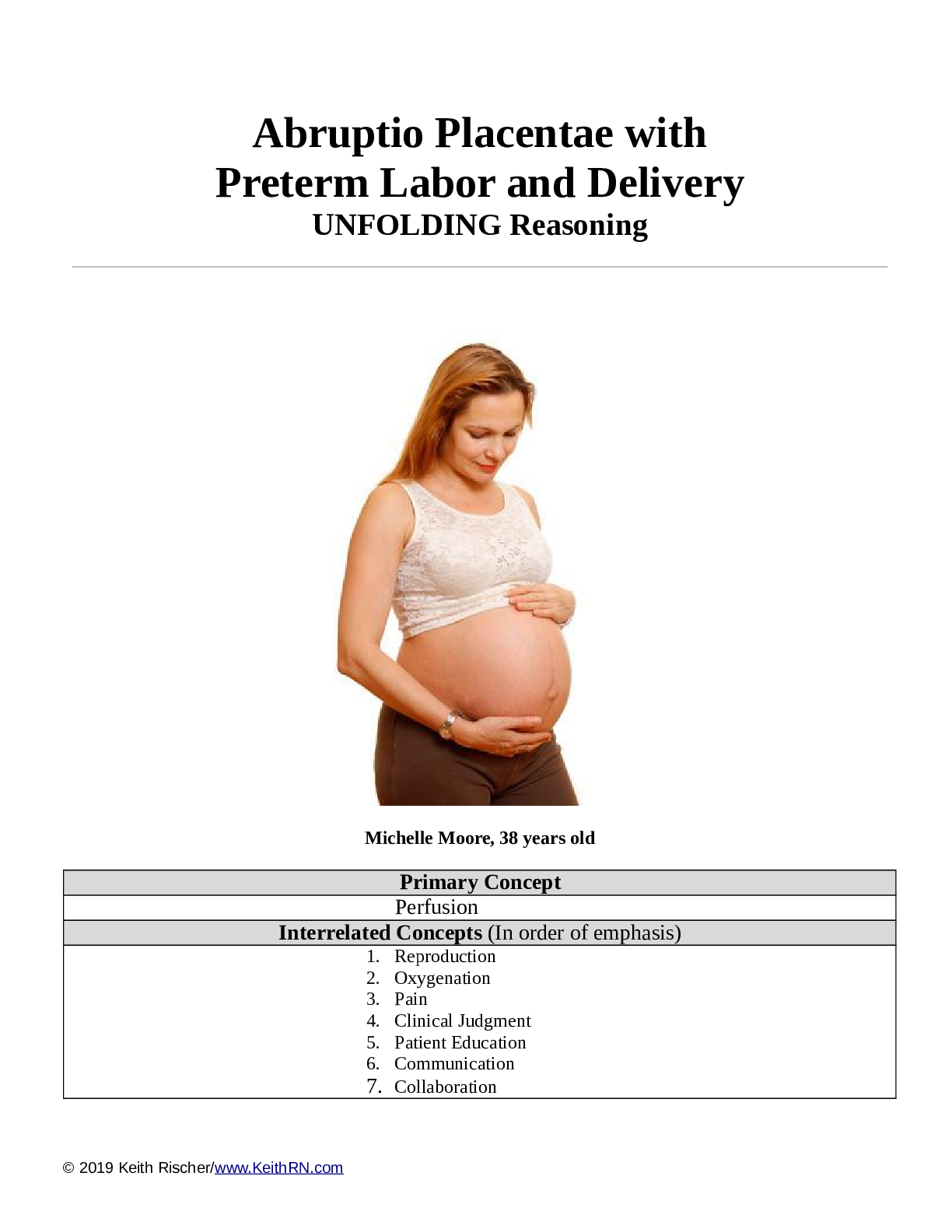
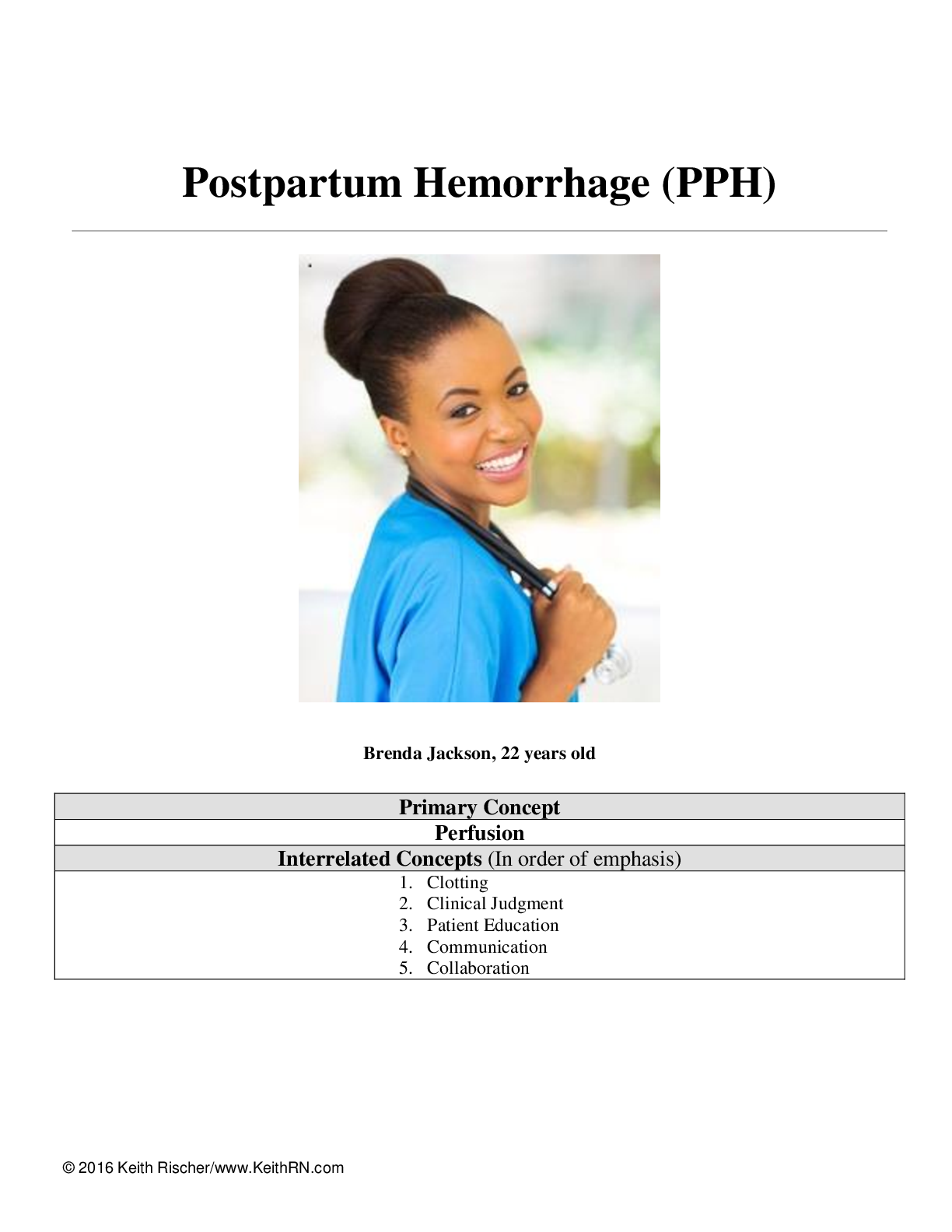
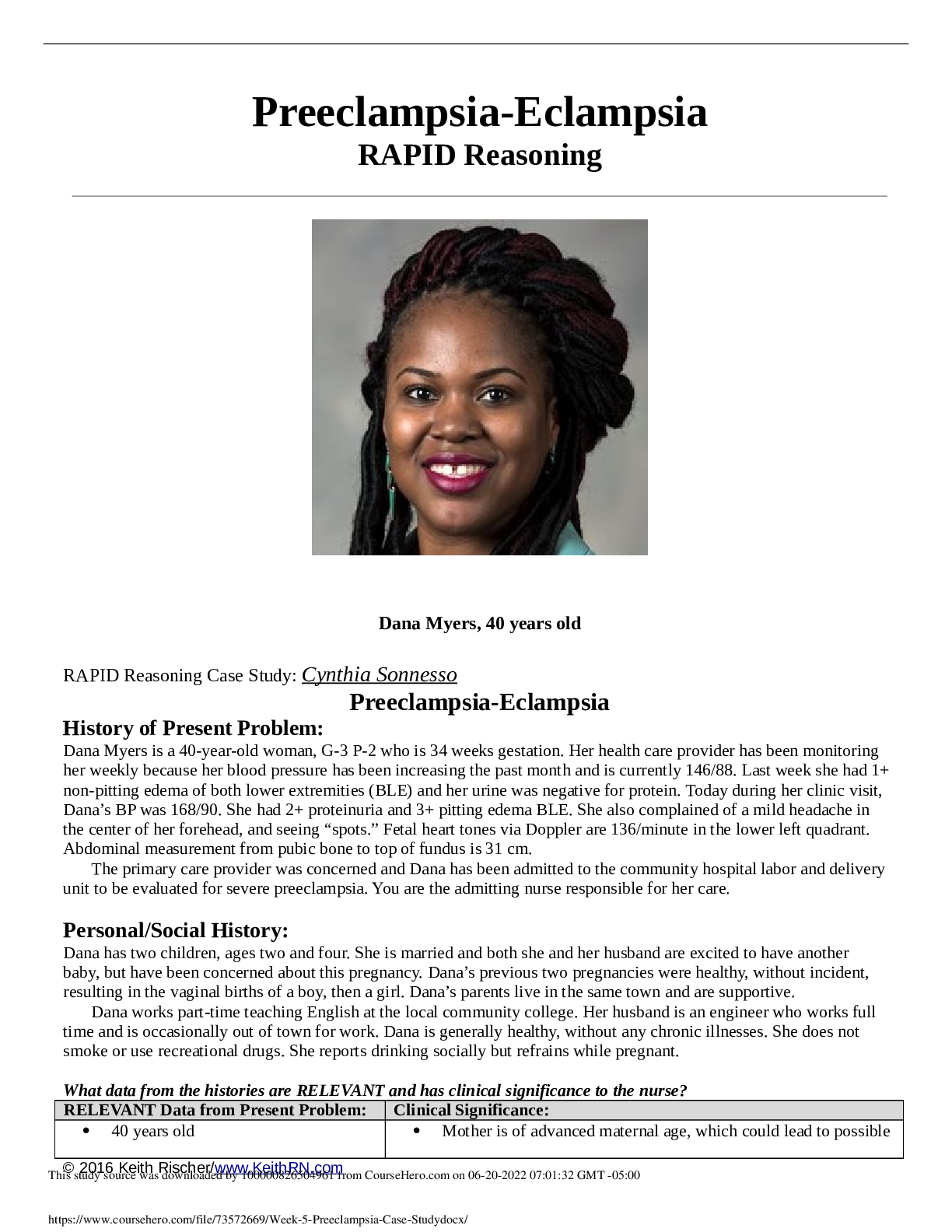

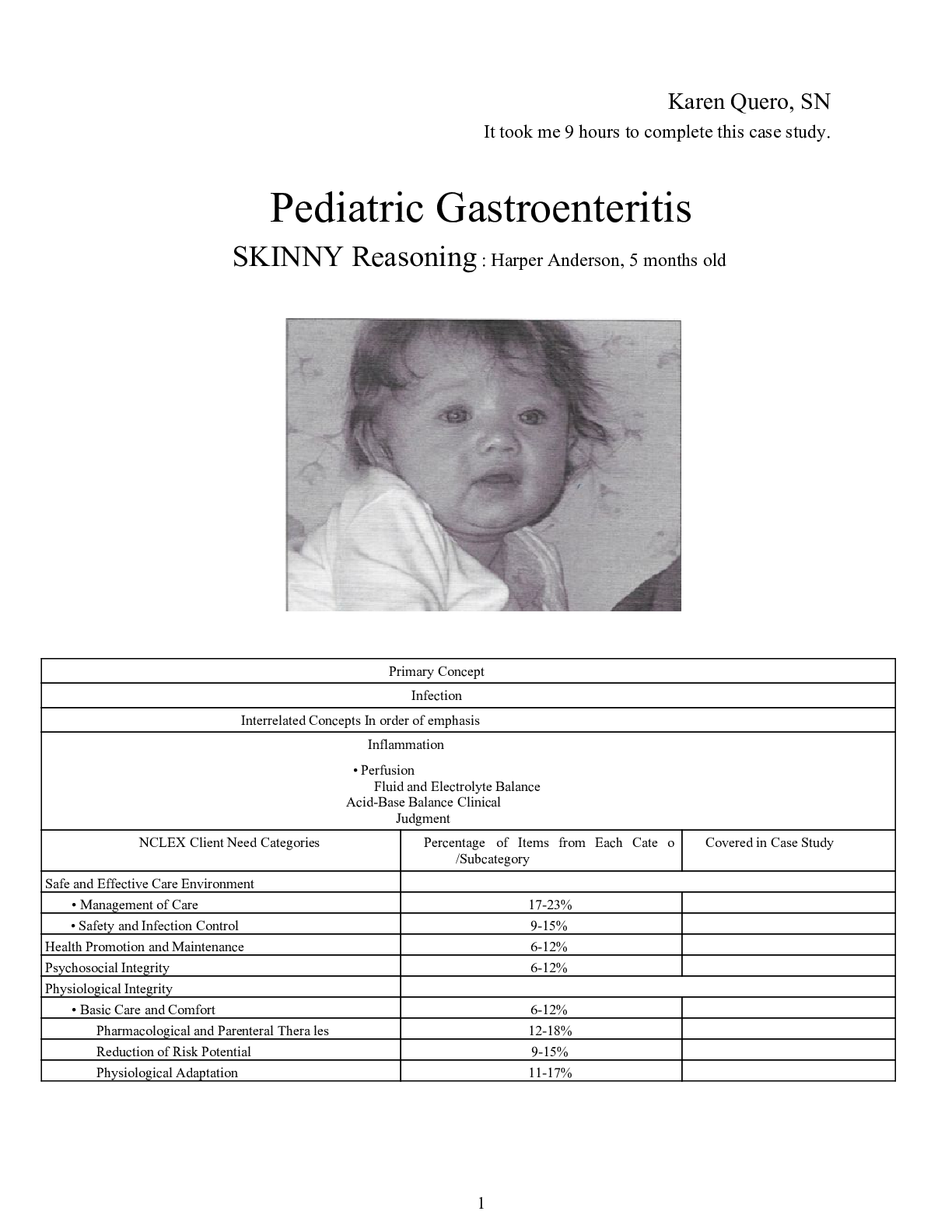

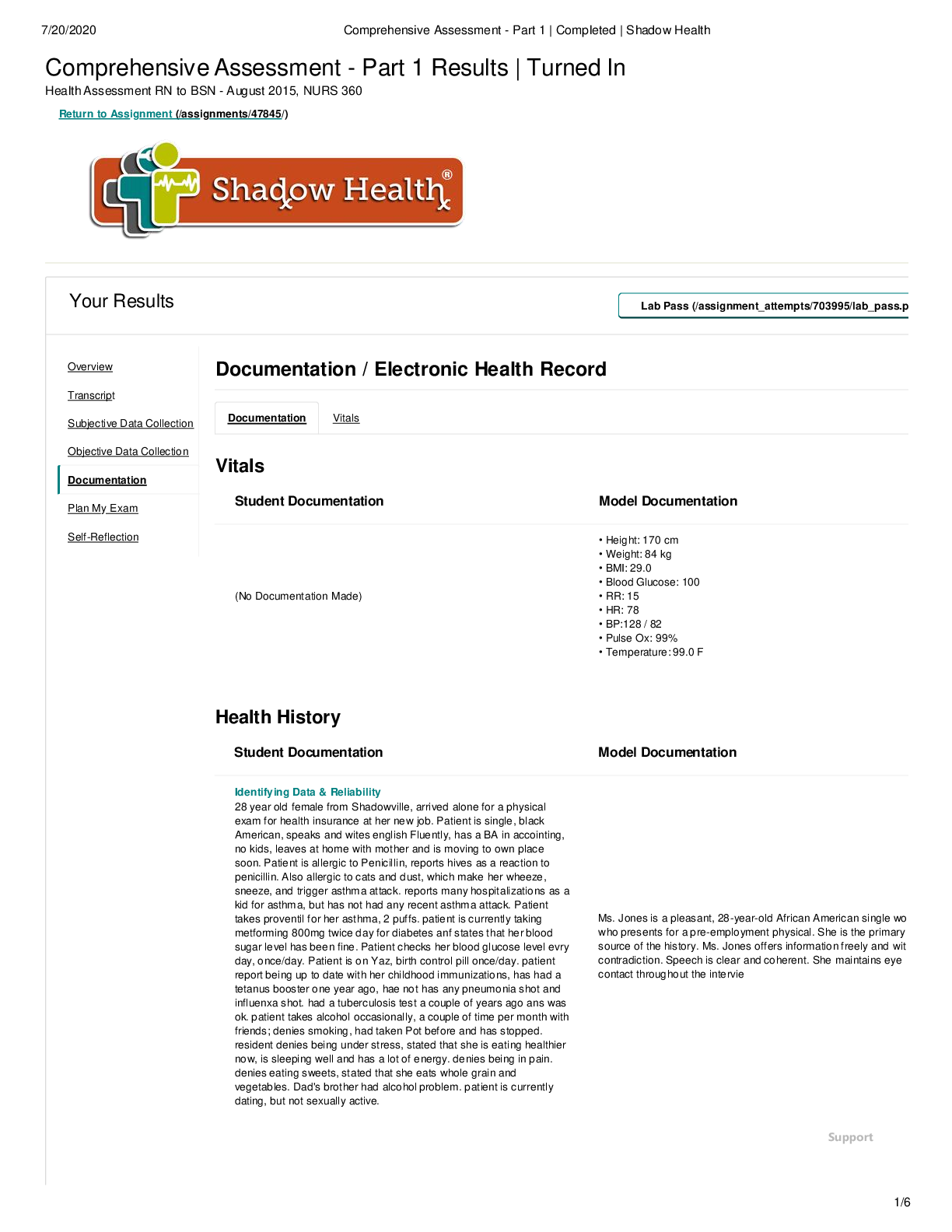
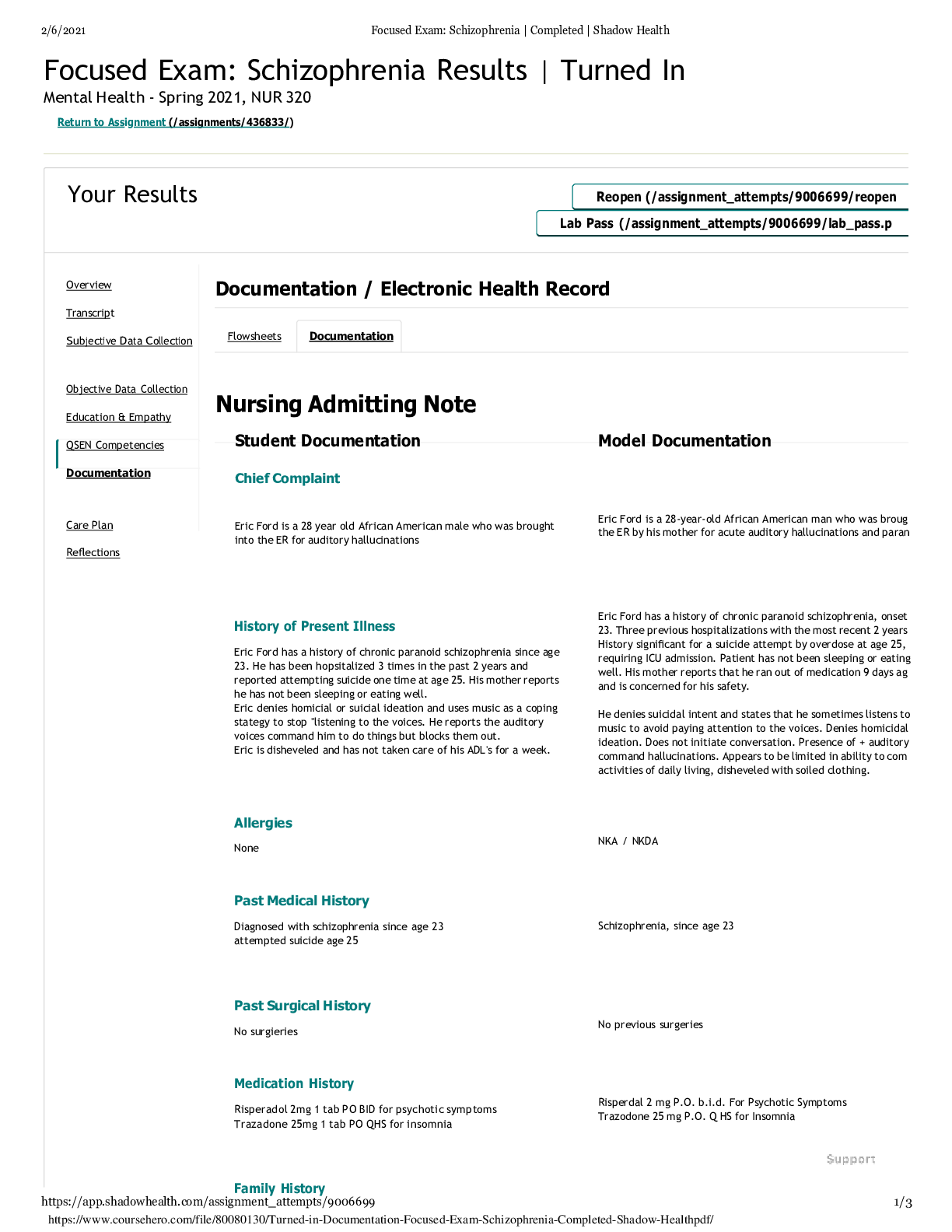
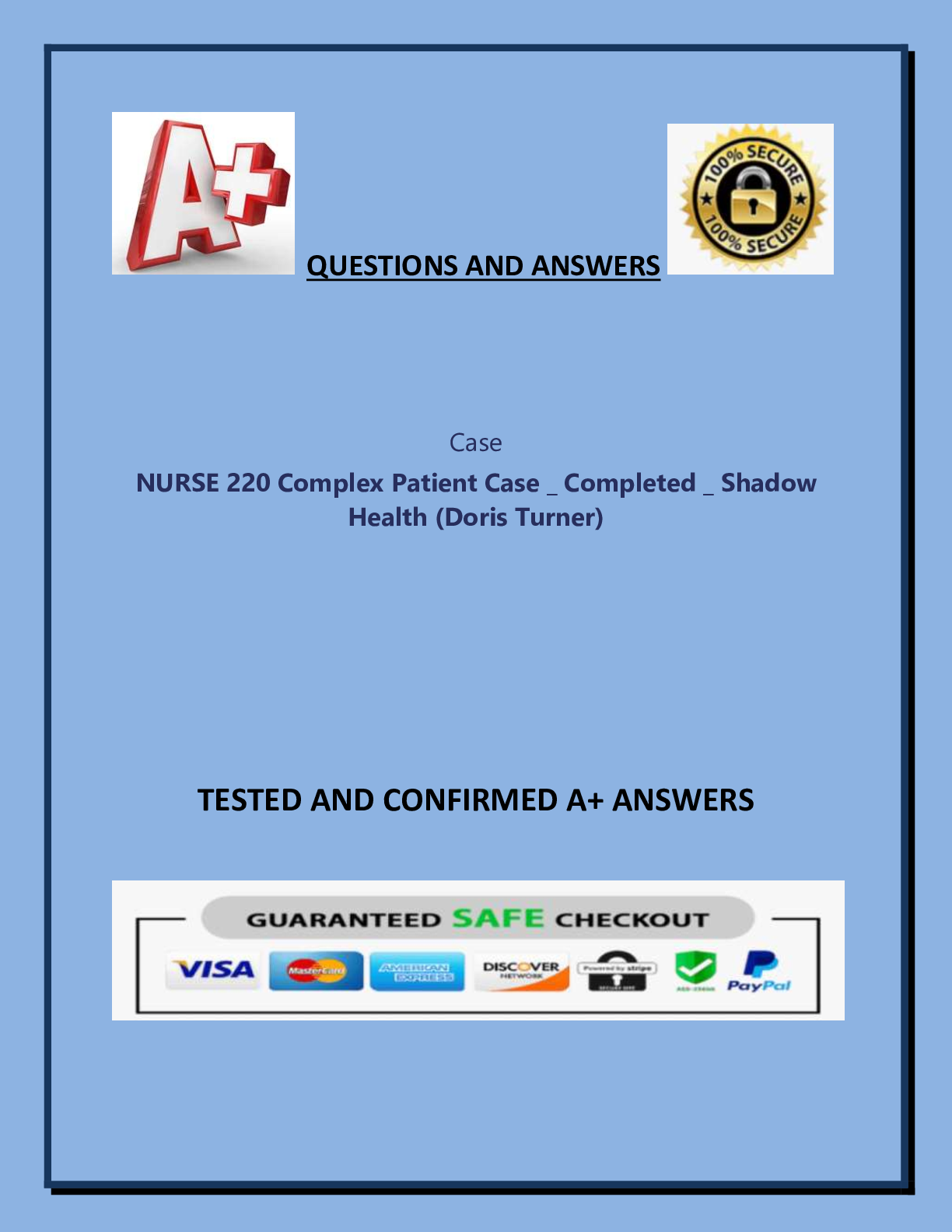
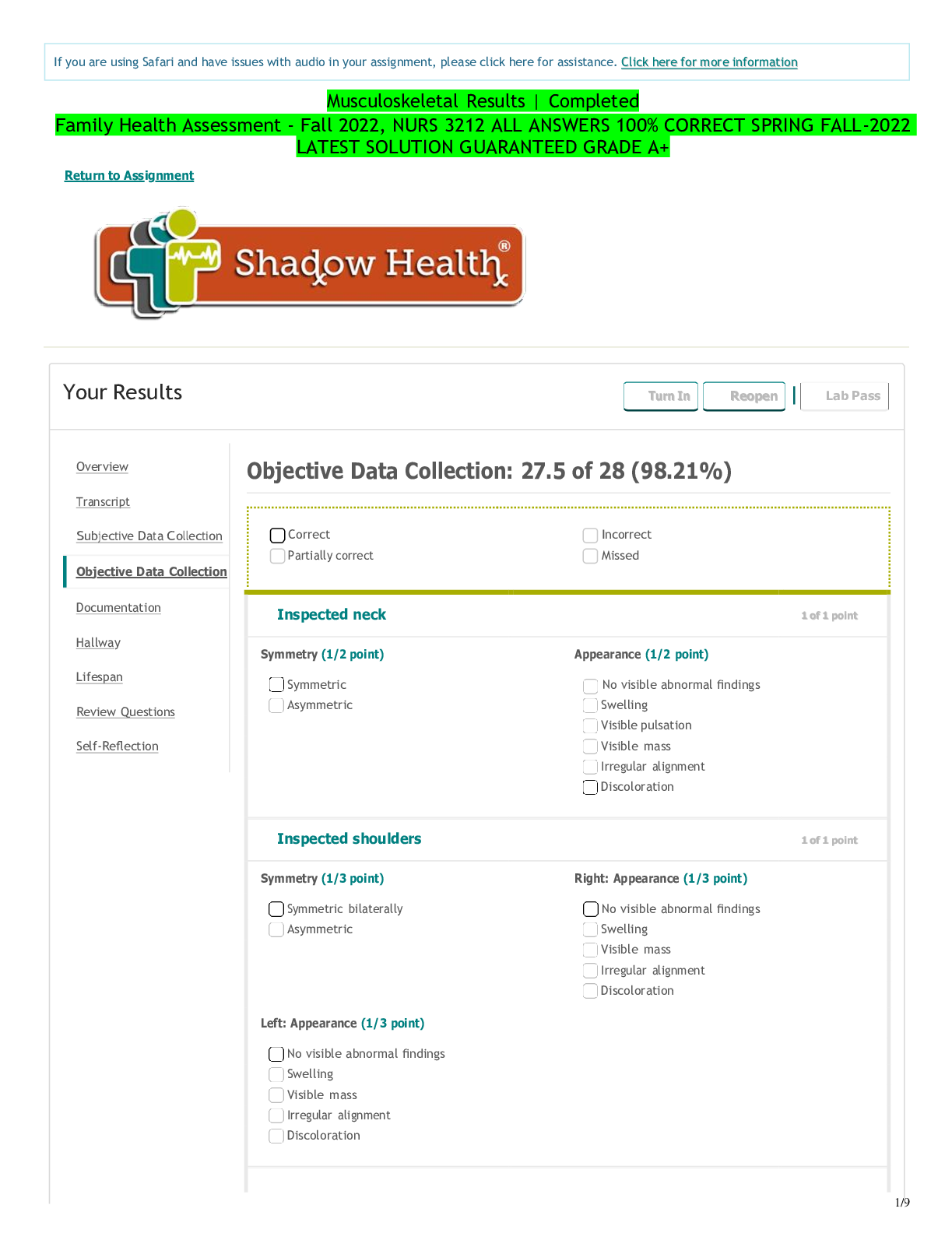
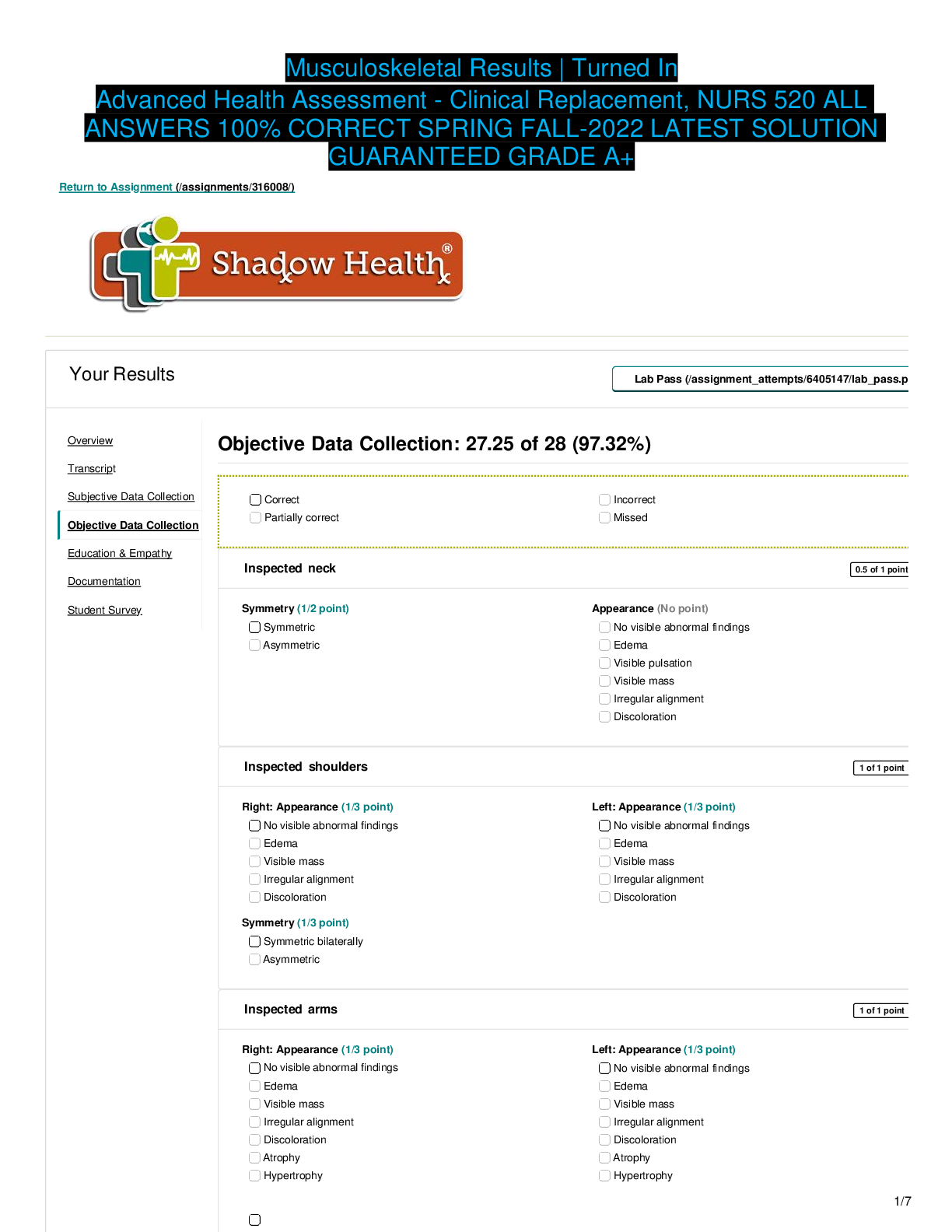
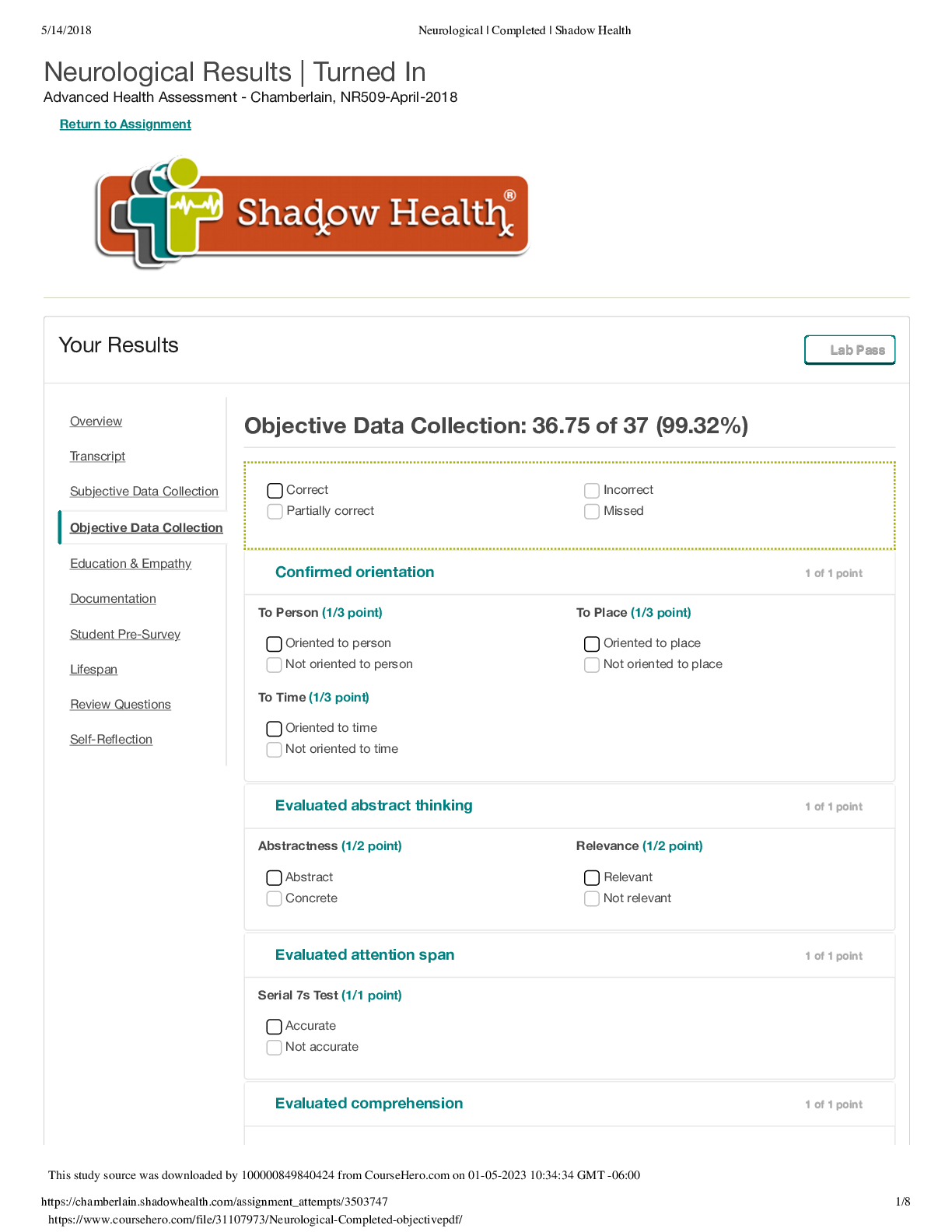
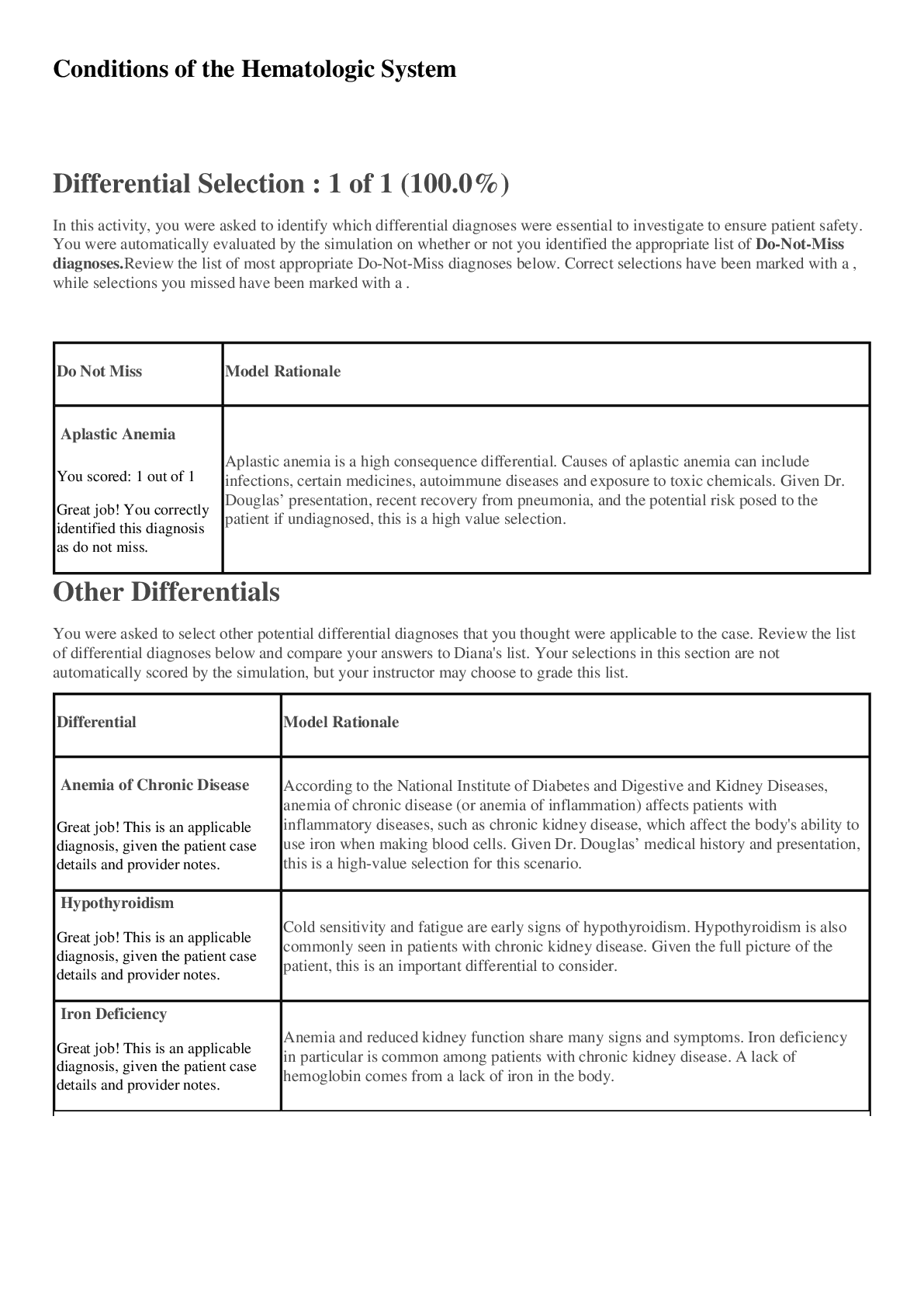
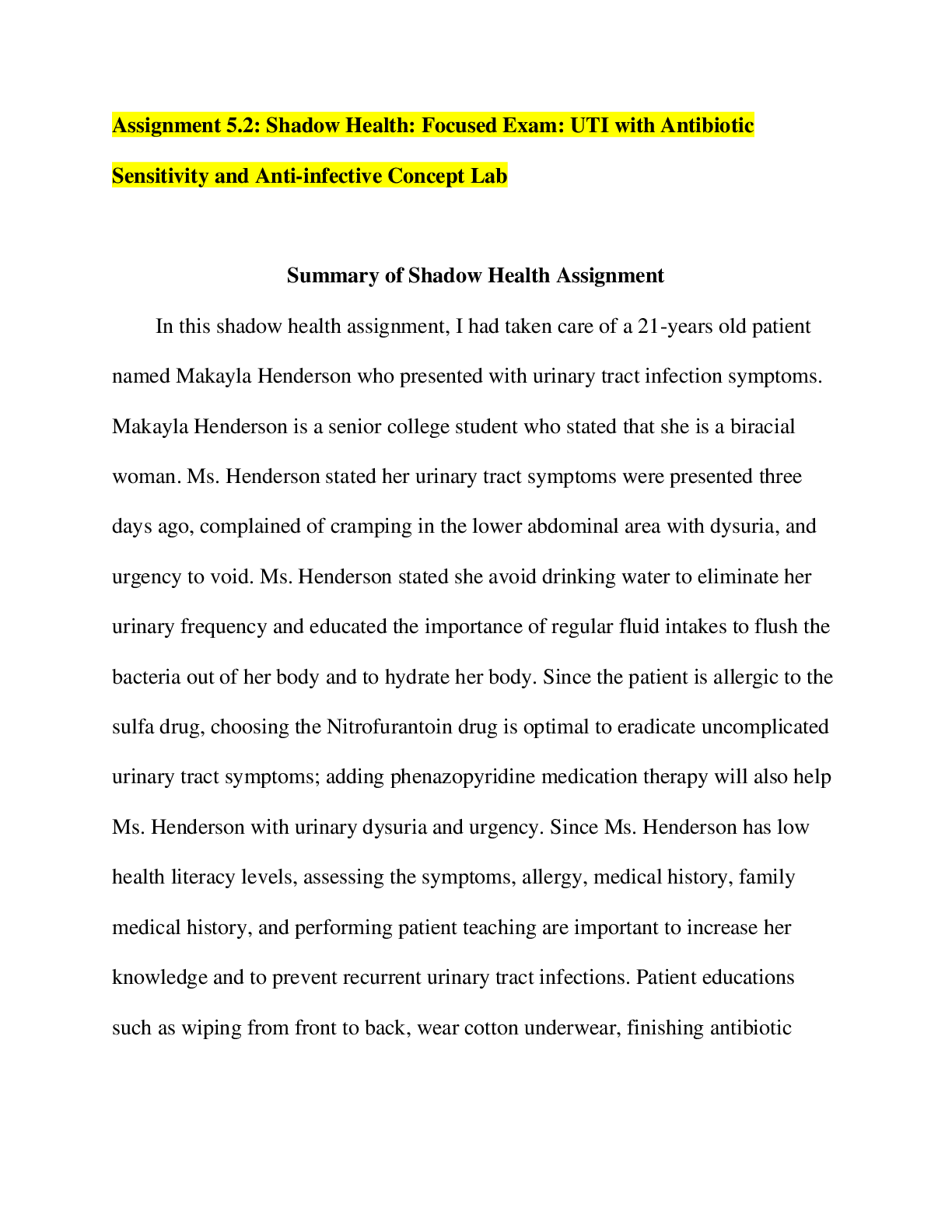
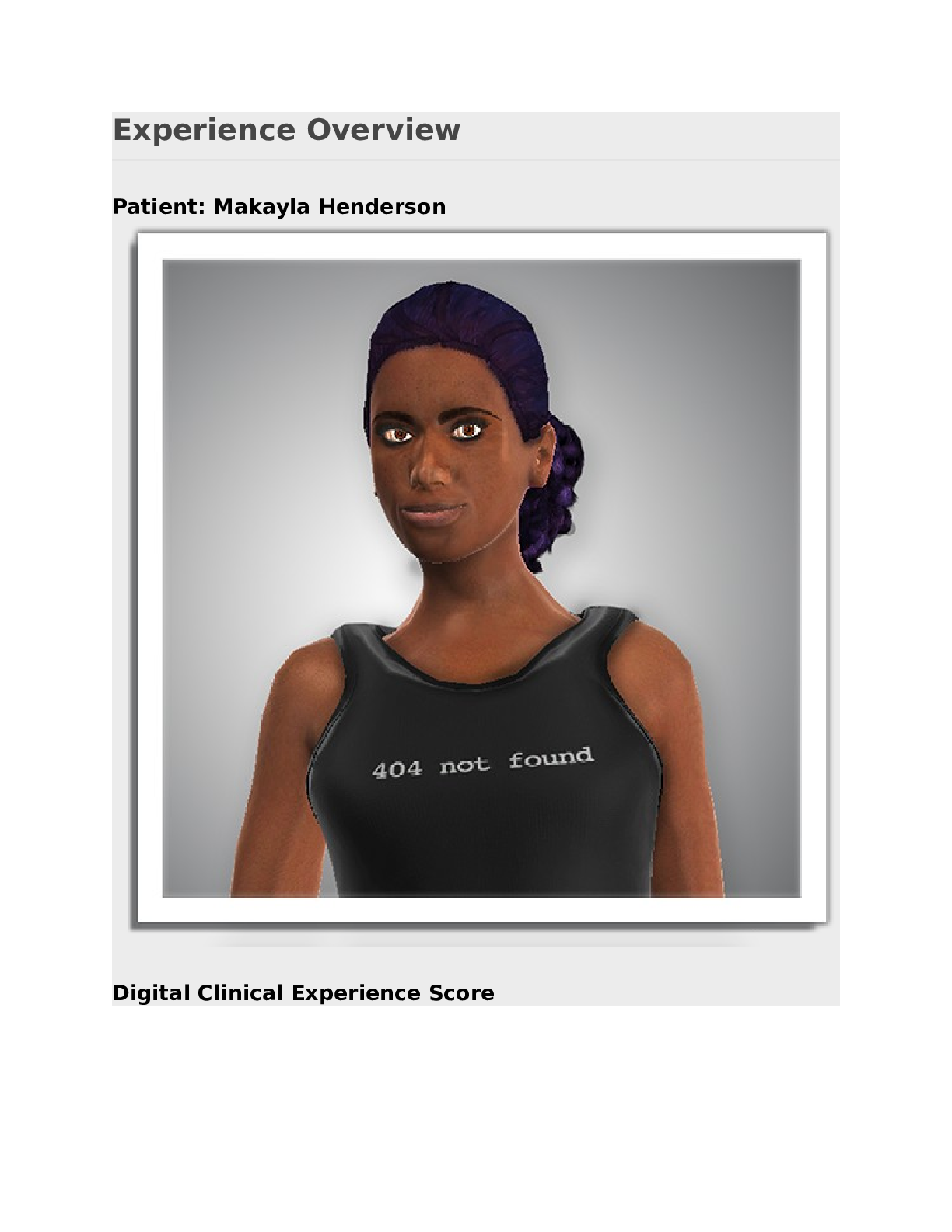
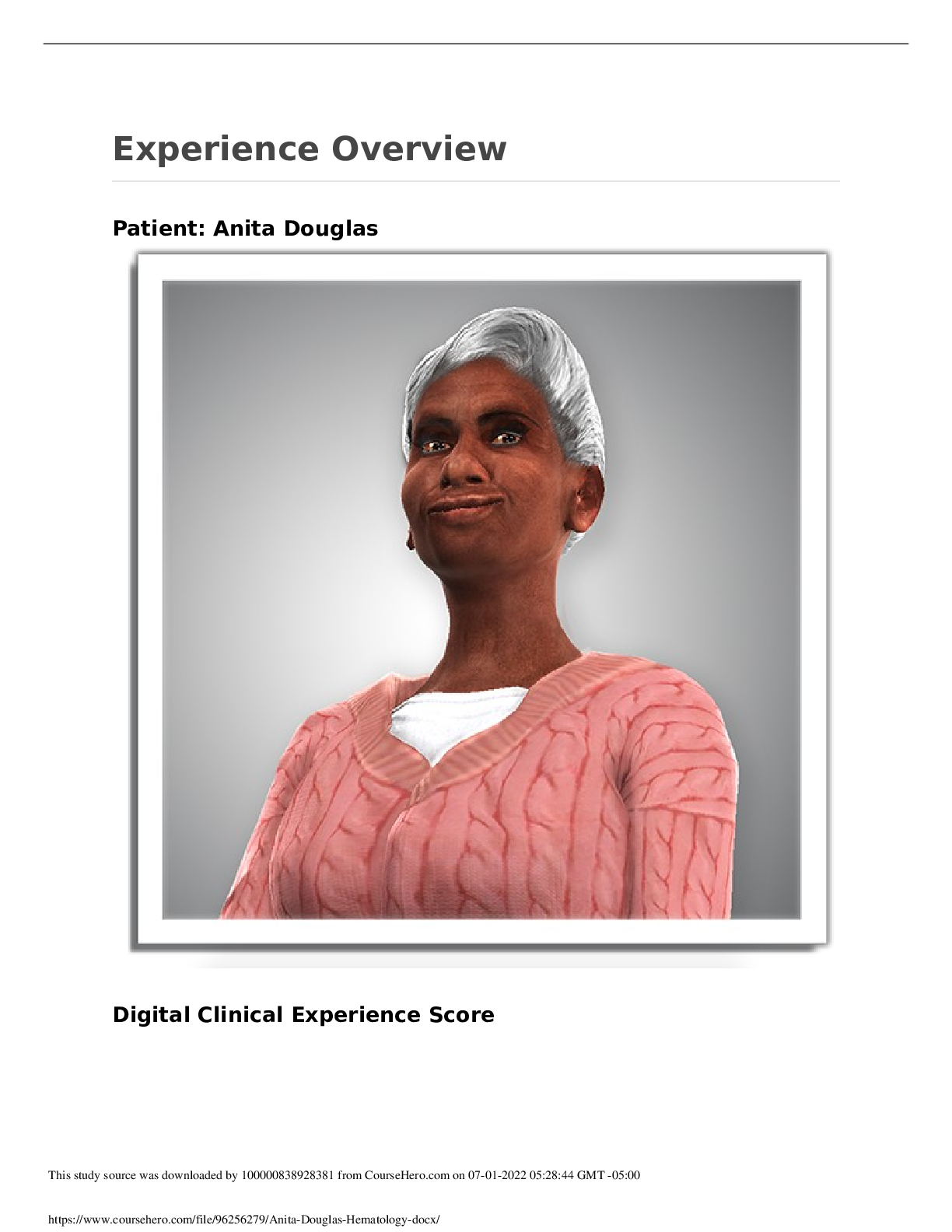
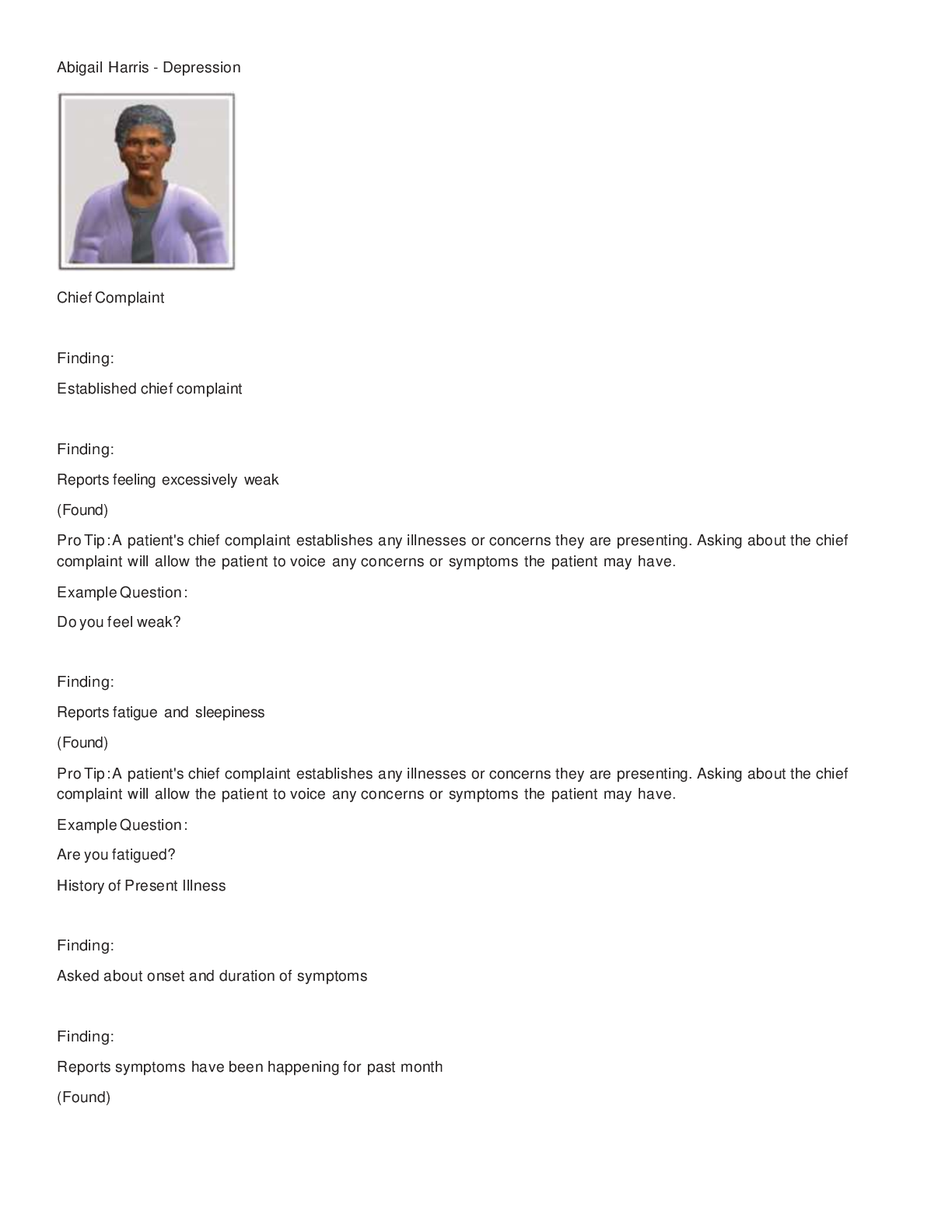
 Transcript.png)
